
cultura e territorio Anno 18Numero 53Dicembre 2022POSTE ITALIANE SPASPEDIZIONE IN ABBONAMENTO POSTALE70%DCB VERONA 2 PREMIO MASI E 250 ANNI UNA FESTA PER DUE MASI PRIZE AND 250 YEARS PARTY FOR BOTH di Gabriele Colleoni 22 MONTELEONE21 PORTA SUL FUTURO MONTELEONE21 BRINGS THE FUTURE a cura della Redazione 48 PERCORSI D’ARTISTA PER LE VIE DI CORTINA IN THE STEPS OF ARTISTS IN CORTINA di Sergio Frigo
Direttore responsabile Gabriele Colleoni
In redazione Dora Stopazzolo Cristina Valenza Elisa Venturini
Traduzioni Stephen Hobley Impaginazione e stampa Tipografia La Grafica Vago di Lavagno (Vr)
Referenze fotografiche
Archivio Fondazione Masi Archivio Masi Archivio Serego Alighieri Gianmarco Chieregato Procuratoria di San Marco Jacopo Salvi Studio Architetti Mar
Hanno collaborato Richard Baudains Sergio Frigo Chandra Kurt Paolo Perazzolo Fabio Piccoli Marco Vigevani
sommario | contents
1 L’anima universale che accompagna il Premio Masi The universal soul that goes with the Masi Prize di Marco Vigevani
2 Premio Masi e 250 anni: il presente si fa già futuro Masi Prize and 250 years: the present is already the future di Gabriele Colleoni
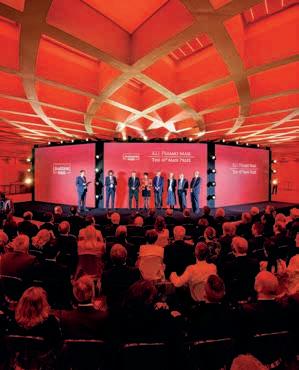
10 “Il nostro impegno quotidiano per la sopravvivenza di San Marco” “Our daily commitment to the survival of St Mark’s” di Paolo Perazzolo
16 Unire le capitali del vino nel segno della sostenibilità e dell’enoturismo Uniting the capitals of wine in the name of sustainability and wine tourism di Chandra Kurt
22 Monteleone21: la porta d’entrata nella Valpolicella del domani Monteleone21: tomorrow’s entry gate for Valpolicella a cura della Redazione / Editorial contribution
28
Eventi senza frontiere per i 250 anni Events abroad to celebrate 250 years a cura della Redazione / Editorial contribution
© 2022 – Fondazione Masi, Villa Serego Alighieri, Gargagnago di Valpolicella (Verona) Testi e immagini possono essere riprodotti, anche parzialmente, con autorizzazione
Pubblicazione realizzata con il contributo di Masi Agricola SpA
Anno 18 - Numero 53 -Dicembre 2022 - pubblicazione quadrimestraleRegistrata presso il Tribunale di Verona il 24 giugno 2005, n. 1669
34 Masi, pionieri anche nella comunicazione Masi, pioneers in communication, too di Fabio Piccoli 42 Continuità e... Masi e il rapporto con il passato Continuity and… Masi and the relationship with the past di Richard Baudains 48 A passeggio per Cortina con gli scrittori che l’amarono Walking in Cortina with the writers who loved it di Sergio Frigo 52 Un Premio Civiltà Veneta come ministro della Giustizia Civiltà Veneta Prize as Minister of Justice a cura della Redazione / Editorial contribution
Dalla Fondazione Masi: flash Newsflash from the Masi Foundation
cultura e
Anno 18 Numero 53 Dicembre 2022 POSTE ITALIANE SPA SPEDIZIONE IN ABBONAMENTO POSTALE 70% DCB VERONA 2 PREMIO MASI E 250 ANNI UNA FESTA PER DUE MASI PRIZE AND 250 YEARS PARTY FOR BOTH di Gabriele Colleoni 22 MONTELEONE21 PORTA SUL FUTURO MONTELEONE21 BRINGS THE FUTURE a cura della Redazione 48 PERCORSI D’ARTISTA PER
di
Frigo In copertina. L’evento celebrativo dei 250 anni di
54
territorio
LE VIE DI CORTINA IN THE STEPS OF ARTISTS IN CORTINA
Sergio
Masi e del Premio Masi 2022 nella nuova struttura ‘Monteleone21’ Cover photograph. Celebratory events for 250 years of Masi and the Masi Prize 2022 in the new ‘Monteleone21’ building
L’ANIMA UNIVERSALE
CHE
ACCOMPAGNA
IL PREMIO MASI THE UNIVERSAL SOUL THAT GOES WITH THE MASI PRIZE
Alcuni filosofi aristotelici, tra i quali il grande Ibn Rashid conosciuto in Occidente come Averroè, sostenevano l’esistenza di un ‘intelletto universale’, superiore e indipendente dai singoli individui e distinto anche da quello divino. La curiosa reminiscenza di lontani studi mi è tornata alla mente ripensando – si parva licet – alle scelte dei ‘laureati’ del nostro Premio Masi. Già l’anno scorso, nel quarantennale, considerando il palmarès dei vincitori, avevo nutrito il sospetto che l’eccel lenza delle scelte non dipendesse tanto dalla capacità di noi giurati quanto da una sorta di ‘anima premii’ che guidava giudiziosamente – e per noi inconsapevolmente – le nostre mani alzate nell’atto del voto. Il sospetto è diventato certezza nell’anno della 250esima vendemmia nel Vajo dei Masi, non nel momento in cui decidemmo di premiare con un unico riconoscimento – Civiltà Veneta e Gros so d’Oro – la Procuratoria di San Marco ma solo allorché, seduto accanto a uno dei Procuratori, ho ascoltato cosa è stato e cosa sia oggi questo istituto.
La Basilica di San Marco non è solo luogo sacro di culto ma è, più di Palazzo Ducale, il simbolo per eccellenza di Venezia e, in senso lato ma proprio, della civiltà veneta nel suo insieme.
La Basilica sorge sull’isola marciana, più bassa di altre e perciò più esposta alle acque alte. L’officina e i laboratori, oltre a occuparsi delle barriere antimarea e del sollevamento dell’isola, concentrano un’incredibile quantità di saperi e di tecniche da tutto il mondo per conservare e restaurare le mi gliaia di manufatti architettonici e artistici di San Marco. Ed ecco, la civiltà di Venezia, che nei secoli ne ha accolto in sé tante altre, si salva oggi soltanto ricevendo da ogni parte del mondo gli strumenti per la sua sopravvivenza futura ma suggellando così, allo stesso tempo, la sua valenza universale.
di Marco Vigevani
Various Aristotelian philosophers, including the great Ibn Rashid, known in the West as Aver roes, have posited the existence of a ‘universal intel lect’, superior to and independent of an individual’s intellect and distinct even from the divine. This chance recollection from studies long ago came into my mind as I considered – si parva licet – the choic es made for the ‘alumni’ of our Masi Prize. Already last year, on the fortieth anniversary, when I saw the list of winners I suspected that the precision of our choices was not down to our ability as jurors but thanks to a sort of ‘anima premii’ that judiciously –even if unconsciously – guided our voting. This suspi cion became certainty in the year of the 250th harvest at Vajo dei Masi, not when we decided to award a single prize – the Civiltà Veneta and Grosso d’Oro together – to the Procuratoria of St Mark, but when I heard one of the Procurators talking about what this institution was and is today. St Mark’s Basilica is not only a sacred place of worship but is, more than the Doge’s Palace, the symbol par excellence of Venice as a city, and, in a broad but real sense, of Venetian civilisation as a whole. The Basilica stands on the island of Marciana, which is lower than others and therefore more sus ceptible to flooding. The workshops and technical departments deal with water barriers and the island’s water level, but they are also the repository for an incredible amount of knowledge, coming from all over the world, used to preserve and restore the thou sands of architectural and artistic artefacts at St. Mark’s. And so the civilisation of Venice, which over the centuries has welcomed so many outsiders, is only saved today using tools for its future survival from all over of the world, which is also confirmation of its universal value.
1
EDITORIALE EDITORIAL EDITORIALE EDITORIAL EDITORIALE EDITORIAL
PREMIO MASI E 250 ANNI: IL PRESENTE SI FA GIÀ FUTURO MASI PRIZE AND 250 YEARS: THE PRESENT IS ALREADY THE FUTURE
di Gabriele Colleoni
A ‘Monteleone21’ la consegna del 41mo Premio Masi e la festa per l’anniversario
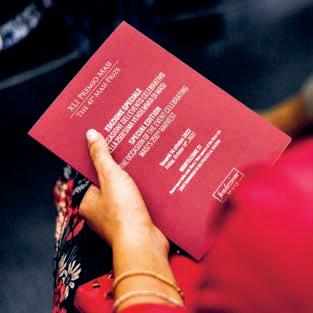
At ‘Monteleone21’ - the 41st Masi Prize ceremony and anniversary party
‘Monteleone21’, anno 250 dalla prima vendemmia nel vigneto Vajo dei Masi; è in questi nuovi spazi che il 14 ottobre scorso la famiglia Boscaini e l’azienda Masi hanno voluto ospitare la cerimonia del Premio Masi 2022, in concomitanza con i festeggiamenti per lo speciale anniversario della storia aziendale. Invitati da tutto il mondo hanno partecipato ad una due giorni, chiusa da una memorabile serata dedicata a due even ti che si sono incrociati nell’unico comun denominato re della civiltà veneta, sotto le volte dell’agorà del mo numentale centro in fase di ultimazione a Gargagnago.
DALLA PIEVE AL NUOVO CENTRO MASI
Se per l’edizione numero 40 nel 2021 il Premio Masi era tornato alle sue origini, nella suggestiva Pieve ro manica di San Giorgio di Valpolicella, quest’anno la scelta della location della cerimo nia è caduta sulla nuova struttura che rappresenterà, una volta com pletata, il riferimento di Masi proiet tata nel terzo millennio e la natura le porta d’accesso enoturistica per i visitatori nelle terre dell’Amarone e della Valpolicella Classica. Apren do per la prima volta i battenti agli
‘Monteleone21’ was the location for the Masi Prize 2022 awards ceremony combined with celebra tions for the 250th anniversary of the first harvest in the Vaio dei Masi vineyard on 14 October this year. Guests from all over the world took part in a twoday event held by the Boscaini family and the Masi winery. The conclusion was a memorable evening dedicated to two important events in the history of Venetian culture celebrated together under the arches of the agora in the monumental new wine centre nearing completion in Gargagnago.
FROM THE PIEVE TO THE NEW MASI CENTRE
If for the 40th edition in 2021 the Masi Prize returned to its origins in the beautiful Romanesque church of San Giorgio di Valpolicella, this year the choice of lo cation for the awards ceremony fell on the new structure which, once completed, will be a Masi ref erence point in the third millenni um and the natural gateway to the lands of Amarone and Valpolicella Classica for wine tourists. Welcom ing guests to Monteleone21 for the first time was the symbolic start
2
La cerimonia di consegna suggella le celebrazioni per la vendemmia n. 250
The awards ceremony crowns the celebrations for vintage no. 250
ospiti, Monteleone21 ha così simbolicamente suggel lato l’inizio di un’ulteriore tappa di sviluppo per le atti vità dell’azienda e, contemporaneamente, del territo rio. Lo ha evidenziato Sandro Boscaini, presidente di Masi Agricola e vicepresidente della Fondazione Masi, il quale, sollecitato dal giornalista Alessandro Milan, in
for the next stage of development both for Masi and for the region. Sandro Boscaini, President of Masi Ag ricola and Vice-President of the Masi Foundation, un derlined the point when journalist Alessandro Milan prompted him to retrace the history of Masi at the beginning of the evening: “This is a very important
L’elegante ricevimento allestito nel fruttaio monumentale The elegant reception held in the imposing grape drying room
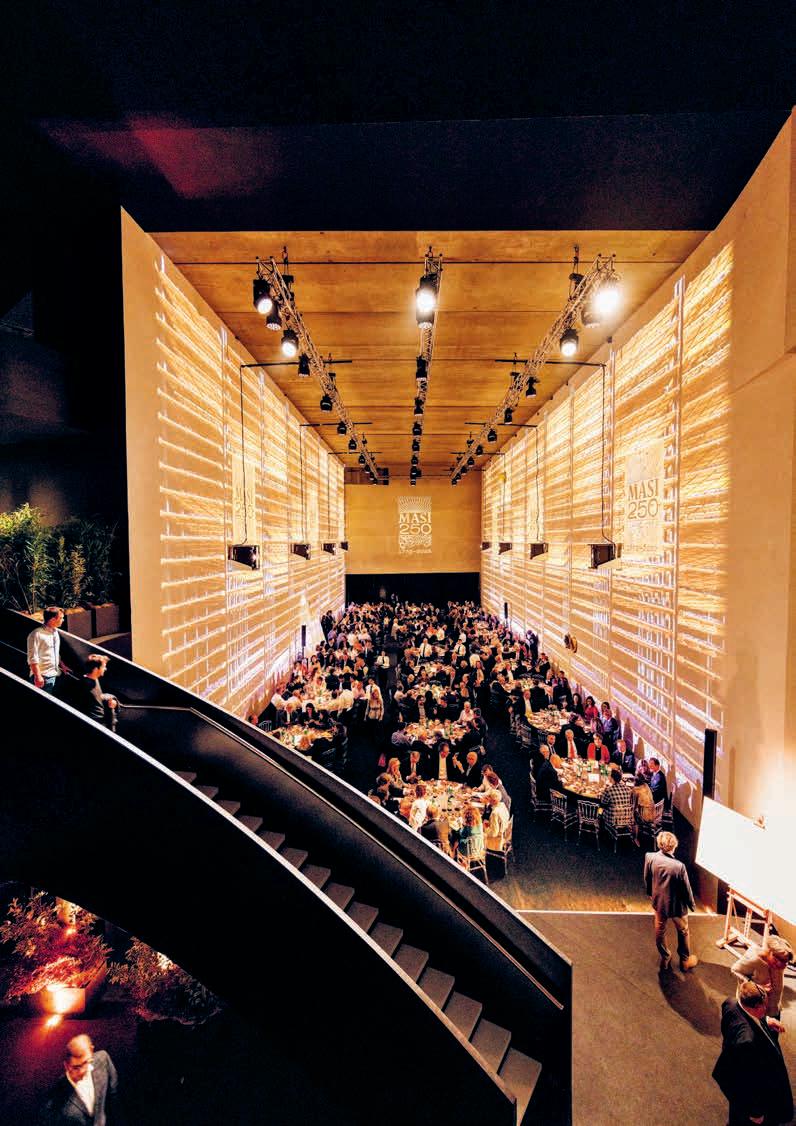
apertura di serata ha ripercorso la storia dell’impresa che ha legato il suo nome anche ad un premio: “Que sto è un evento di grande significato per il nostro gruppo, e ancora di più per me che ho avuto la for tuna e l’onore di partecipare a quello per i 200 anni

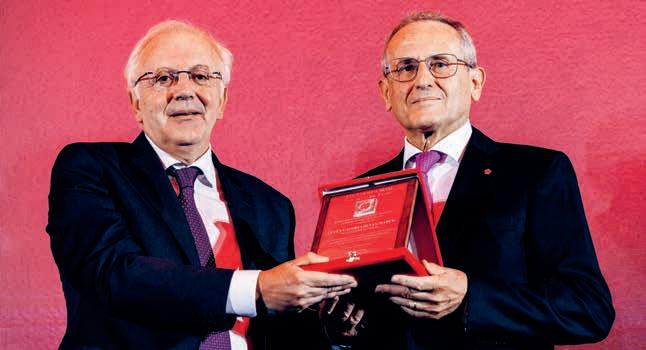
event for our group, and even more so for me who had the good fortune and honour of participating in the 200th anniversary in 1972, when the new ageing cellar was opened. This year we are happy to be able to celebrate this new milestone in the company of
 Marco Vigevani, Isabella Bossi Fedrigotti e Sandro Boscaini con i premiati davanti alla botte del Premio Isabella Bossi Fedrigotti, Marco Vigevani and Sandro Boscaini with the winners in front of the Prize Barrel
Marco Vigevani, Isabella Bossi Fedrigotti e Sandro Boscaini con i premiati davanti alla botte del Premio Isabella Bossi Fedrigotti, Marco Vigevani and Sandro Boscaini with the winners in front of the Prize Barrel
Pagina precedente.
Il Prefetto di Verona Cafagna consegna la targa alla Procuratoria di San Marco nella persona di Bruno Barèl Preceding page Prefect of Verona Donato Cafagna awards the Grosso d’Oro to the Procuratoria of St Mark represented by Bruno Barèl
A lato. Il Grosso d’Oro a Catherine Leparmentier Dayot e Juan Maria Saenz de Buruaga della Great Wine Capitals

This page. The Grosso d’Oro is also awarded to Great Wine Capitals represented by Catherine Leparmentier Dayot and Juan Maria Saenz de Buruaga
nel 1972, quando venne inaugurata la nuova cantina di invecchiamento. Quest’anno siamo felici di poter festeggiare il nuovo traguardo incontrando qui istitu zioni, stampa, imprenditori, i nostri importatori e col laboratori, sia italiani che stranieri”.
DUE GROSSO D’ORO SPECIALI
“L’occasione della ricorrenza – ha sottolineato Sandro Boscaini – ci consente di consolidare il legame col no stro territorio, con la civiltà veneta alla base della no stra storia imprenditoriale, e con il Premio Masi che fin dalla sua istituzione nel 1981 si è proposto di va lorizzare le eccellenze delle Venezie e il loro costante rinnovarsi”. Un legame speciale con il territorio che, secondo Raffaele Boscaini, direttore marketing del gruppo Masi, “nella gestione dell’azienda ci respon sabilizza ancor di più nei confronti della comunità in cui operiamo”. Nell’illustrare le motivazioni dell’asse gnazione del premio e introdur re i vincitori, la presidente della Fondazione Masi Isabella Bossi Fedrigotti ha spiegato che “Per i 250 anni il Consiglio di Fon dazione ha voluto unire ecce zionalmente nel Grosso d’Oro Veneziano sia il Premio Civiltà Veneta che il Premio Internazio
dignitaries, the press, entrepreneurs, our importers and colleagues, both Italian and foreign”.
TWO SPECIAL GROSSO D’ORO PRIZES
Un legame che si consolida con la civiltà veneta valorizzandone le eccellenze
The link with the culture of the Veneto consolidated by promotion of its excellence
“This anniversary,” Sandro Boscaini emphasises, “al lows us to consolidate our bond with our region, and with the Venetian culture that underpins our entrepreneurial history, as well as with the Masi Prize, which has had the promotion of the premium products of the Venetian regions and their constant renewal as its aim since its foundation in 1981.” It’s a special bond with the land, that as Raffaele Boscaini, Marketing Director of the Masi Group, says, “makes us even more responsible to the community in which we operate in terms of company manage ment.” Presenting the citations for the Masi Prize awards and introducing the winners, the President of the Masi Foundation, Isabella Bossi Fedrigotti, ex plained that “For its 250th anni versary, the Foundation Board decided, for this time only, to merge both the Civiltà Veneta Prize and the Civiltà del Vino Prize with the Grosso d’Oro Veneziano, because now is the moment to honour two em blems of Venetian civilisation
5
L’applaudito talk show, presentato da Alessandro Milan nell’Agorà dei nuovi spazi di Gargagnago, era anche in diretta streaming The lively talk show, fronted by Alessandro Milan in the Agorà of the new building at Gargagnago, was also streamed live


nale Civiltà del Vino, a significare che oggi è arrivato il momento di onorare gli emblemi della civiltà veneta e della cultura del vino con il nostro massimo ricono scimento, attribuito rispettivamente alla Procuratoria della Basilica di San Marco e al Great Wine Capitals”. La prima per “lo straordinario impegno profuso nel la conservazione e nella valorizzazione della Basilica, Patrimonio dell’umanità Unesco e simbolo senza pari di una storia e civiltà più che millenaria, nonché per la promozione di iniziative culturali e museali di altissi mo profilo”. Il secondo per essere “l’espressione più attuale della simbolicità dei valori del vino”. Sostiene infatti “la pregnanza culturale e i poliedrici aspetti del vino e del suo mondo: storia, territori, vi tigni, saper fare di uomini fino ai più recenti significati di rappresentatività dei territori, incluso l’aspetto am bientale, emozionale e turistico”.
A questo fine, la rete è impegnata a livello globale a creare sinergie tra le grandi aree viticole.
I premi sono stati ritirati dal pro curatore della Basilica Bruno Ba rel a nome del Primo Procurato re Carlo Alberto Tesserin, e dalla francese Catherine Leparmentier Dayot e dallo spagnolo Juan Ma ria Saenz de Buruaga, rispettiva
and wine culture with our highest recognition: they are, respectively, the Procuratoria of the Basilica of St Mark and the Great Wine Capitals.”
The first receives its award for “an extraordinary com mitment to the preservation and enhancement of the Basilica, a UNESCO World Heritage Site and the unique symbol of a history and culture more than a thousand years old, as well as for the organisation of cultural and museum initiatives of the highest order”. The second is awarded for being “the most up-to-date expression of the symbolism of the values of wine”. More precisely, this institution supports “the cultural relevance and multifaceted significance of wine in all its aspects: history, regions, grape varieties, and skill in vinification, right up the more recent areas of attention – the environment, tourism and public opinion.” To ad dress these matters, the Network is globally committed to creat ing synergies between the major wine-growing areas.
Great Wine Capitals: “espressione più attuale della simbolicità dei valori del mondo del vino”
Great Wine Capitals: “the most up-to-date expression of the symbolism of the values of wine”
The two Prizes were collected by Basilica Procurator Bruno Barel on behalf of the Head Procurator Carlo Alberto Tesserin, and by Frenchwoman Catherine Lepar mentier Dayot and Spaniard Juan Maria Saenz de Buruaga, respec
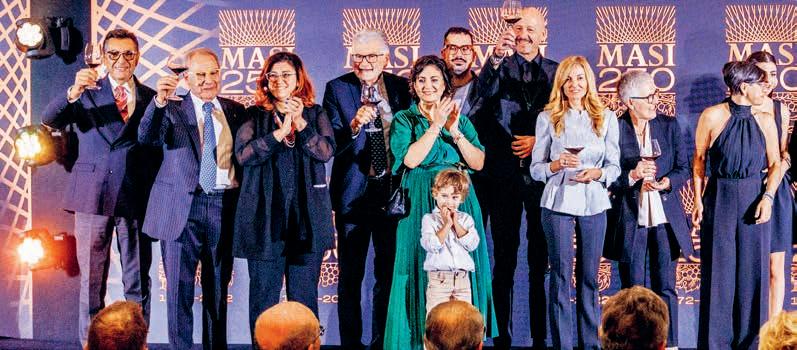
8
mente managing director e vicepresidente del Great Wine Capitals.
Il Premio Masi e l’evento celebrativo dei 250 anni hanno confermato in modo lampante il legame for te ed essenziale tra una dimensione locale dalle pro fonde radici storico-culturali, alla sempre più ampia proiezione internazionale, articolata in un proficuo reciproco scambio in grado di arricchire tutto il ter ritorio. L’evento concluso da una cena di gala con 300 ospiti nel nuovo scenografico fruttaio di ‘Monteleone21’ è così risultato all’altezza della secolare storia dell’azienda e soprattutto già in cammino verso un fu turo orientato a nuovi e ambiziosi progetti nel segno della sostenibilità ambientale, economica e sociale.
Gabriele Colleoni, giornalista, è stato caporedattore de ‘L’Arena’ di Verona ed è ora vicedirettore del ‘Giornale di Brescia’ e direttore della rivista ‘Le Venezie’. Si è occupato di America Latina e cooperazione internazionale.

Ha collaborato anche con Radio Vaticana.


A chiusura della serata, il brindisi della famiglia Boscaini al completo
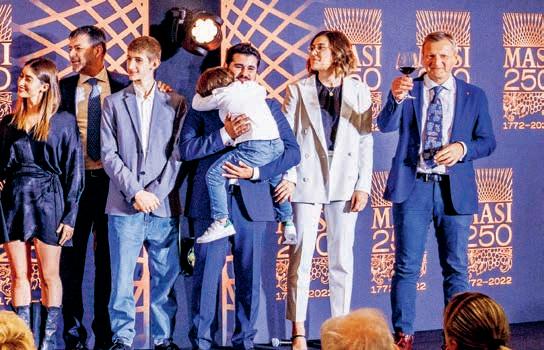
The Boscaini family salute assembled guests with a toast at the end of the evening
tively Managing Director and Vice-President of Great Wine Capitals.
The event held to celebrate the Masi Prize and the company’s 250th anniversary is clear confirmation of the strong link between a local enterprise with deep historical and cultural roots and an increasingly wider international platform, resulting in a profitable mu tual exchange capable of enriching the entire region. This event, concluding with a 300-guest gala dinner held in the imposing new fruttaio at ‘Monteleone21’, was truly worthy of the centuries-old history of a company already on its way to a future of new and ambitious projects in the name of environmental, economic and social sustainability.
9
Gabriele Colleoni, journalist, former editor-in-chief of ‘L’Arena’, now deputy editor of the ‘Giornale di Brescia’ and editor of the magazine ‘Le Venezie’. Has covered Latin America and international co-operation for many years. Has worked in the news service for Vatican Radio.
LA CERIMONIA (INTEGRALE)
www.fondazionemasi.com
THE CEREMONY (FULL VERSION)
La Basilica di San Marco di Venezia è uno degli emble mi dell’arte e della spiritualità nel mondo. Luogo d’in contro fra Occidente e Oriente, questo affascinante edificio affonda le sue origini nel primo millennio, poi viene modificato nei secoli e incessantemente arric chito di colonne e superfici marmoree, fino a diven tare patrimonio Unesco: “un prezioso reliquiario, un libro di preghiera miniato in oro e alabastro”, come ebbe a definirlo lo scrittore inglese John Ruskin. Se tutti conosciamo il valore culturale di questa stra ordinaria basilica, pochi immaginano che cosa signifi chi conservarla e tutelarla, specie in una città laguna re come Venezia e in un’epoca di forti cambiamenti climatici che aggravano il fenomeno dell’acqua alta. Proprio per attirare l’attenzione su questa complessa condizione, con lungimi ranza il Premio Masi ha voluto asse gnare uno dei suoi riconoscimenti del 2022 alla Procuratoria della Basilica di San Marco a Venezia: un ente antichis simo e prestigioso, al punto che nem meno la caduta della Serenissima poté oscurarne l’esistenza, perché l’antico nome attribuito alla fabbriceria è sta

St Mark’s Basilica in Venice is one of the world’s most iconic symbols of art and spirituality. A meet ing place between the West and the East, this stu pendous building had its origins in the first millen nium AD, before being modified over the centuries and continually enriched with columns and marble surfaces. Now a UNESCO heritage site, it was fa mously described by English author John Ruskin as: “a precious reliquary, a prayer book illuminated in gold and alabaster”.
PROCURATORIA DI SAN MARCO
While we all know the cultural value of this extraordi nary church, few realise what is involved in the work of preserving and protecting it, espe cially in a lagoon city like Venice where climate change is aggravating the phe nomenon of ‘acqua alta’, or flooding. It was to draw attention to this complex condition that the Masi Prize decided to give one of its 2022 awards to the Procuratoria of St. Mark’s Basilica in Venice, an ancient and prestigious body that survived the fall of the Se renissima to be granted its charter by Royal Decree on 9th July 1931. “We need a staff of about one hundred to
10
PREMIO MASI MASI PRIZE
“IL NOSTRO IMPEGNO QUOTIDIANO PER LA SOPRAVVIVENZA DI SAN MARCO”
“OUR DAILY COMMITMENT TO THE SURVIVAL OF ST MARK’S”
di Paolo Perazzolo
Intervista a Carlo Alberto Tesserin, Procuratore della Basilica simbolo di Venezia Interview with Carlo Alberto Tesserin, Procurator of Venice’s emblematic Basilica
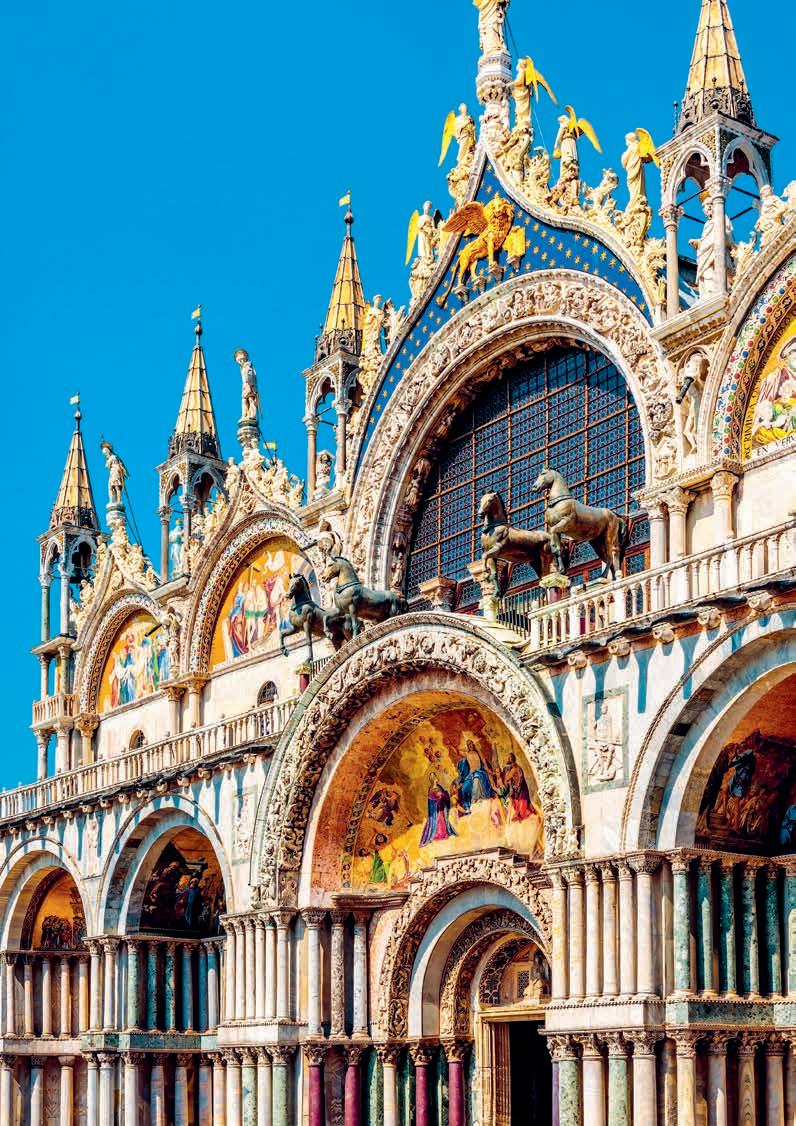 La Basilica e il Leone di San Marco, simbolo universale di Venezia, custoditi dalla Procuratoria
The universal symbol of Venice: the Basilica with the Lion of St Mark, under the tutelage of the Procuratoria
La Basilica e il Leone di San Marco, simbolo universale di Venezia, custoditi dalla Procuratoria
The universal symbol of Venice: the Basilica with the Lion of St Mark, under the tutelage of the Procuratoria
to riconosciuto con Regio Decreto del 9 luglio 1931. “Per tenere in vita questo organismo vivente sono ne cessari un centinaio di addetti”, spiega Carlo Alberto Tesserin, Primo Procuratore della Procuratoria della Basilica. “Il Consiglio della Procuratoria, formato da 7 membri, designa un architetto, detto ‘proto di San Marco’, cui è affidata la direzione dei servizi tecnici per la conservazione degli edifici e dei tesori in essa conservati, rispettando le esigenze del culto e le di sposizioni del Patriarcato di Venezia”. Dal 2016 questo fondamentale ruolo è affidato all’ar chitetto Mario Piana, dopo illustri predecessori qua li Jacopo Tatti, detto il Sansovino (dal 1529 al 1570), l’arch. Ferdinando Forlati (dal 1948 al 1972) e l’arch. Et tore Vio (dal 1981 al 2016). Una particolare cura richie de l’incredibile patrimonio di mosaici, che rivestono per 8.000 metri quadrati le pareti. “Sono affidati a un piccolo eserci to di 60 dipendenti a cui si aggiun gono le cooperative di servizi e la guardiania, per un costo comples sivo di 12 milioni di euro fra dipen denti, tecnici, materiali ed esercizi di culto, cui devono far fronte gli incassi delle biglietterie, oltre ai fi nanziamenti della Regione e del Go verno”, specifica Tesserin. Contro il
keep this living organism alive,” explains Carlo Alberto Tesserin, First Procurator of the Basilica. “The Procu ratoria Council, made up of seven members, appoints an architect, known as the ‘Proto di San Marco’, who oversees the technical work involved in the conser vation of the building and treasures preserved in it while respecting the requirements of worship and the provisions of the Patriarchate of Venice.”
Since 2016, this important function has been entrust ed to Arch. Mario Piana who follows in the footsteps of luminaries including Jacopo Tatti, called Sansovino (1529-1570), Arch. Ferdinando Forlati (1948-1972) and Arch. Ettore Vio (1981-2016). Special care is required for the incredible patrimony of mosaics, covering 8,000 square metres of the walls.
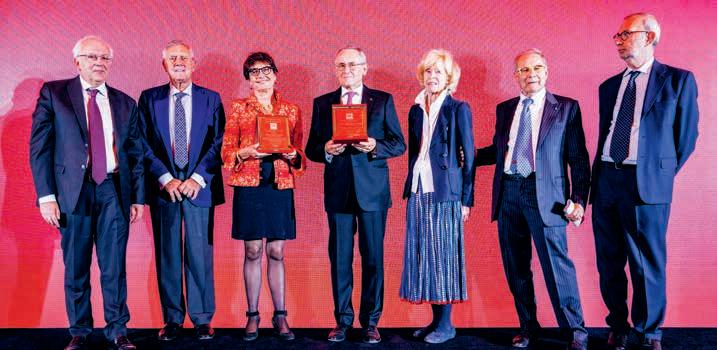
Le due sfide prioritarie: contrastare i rischi dell’acqua alta e regolare il gran flusso di turisti The two most urgent challenges: combatting the floods and regulating the great flow of tourists
“They are entrusted to a small army of 60 employ ees, plus the cooperatives of ser vice and security staff, for a total cost of 12 million euros split be tween employees, technicians, ma terials and church services, which must be met by the takings of the ticket offices, in addition to fund ing from the regional and national governments,” says Tesserin. Out side, a glass wall is being erected to protect against flooding. “We ex
12
fenomeno dell’acqua alta si sta allestendo all’esterno una recinzione di vetro. “Entro il mese contiamo di completarne l’installazione”, continua il Primo Procu ratore, “nella speranza che si riveli efficace. Da 3 anni – probabilmente a causa del cambiamento climatico –
Pagina precedente e sotto Alcuni momenti della premiazione sul palcoscenico dell’Agorà Previous page and below The awards ceremony on stage at the Agorà
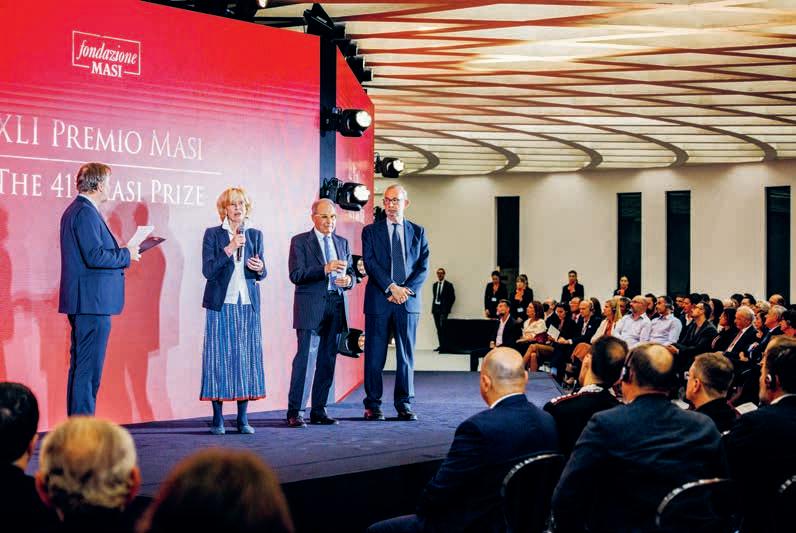
A lato. L’acqua alta minaccia costantemente i tesori della Basilica
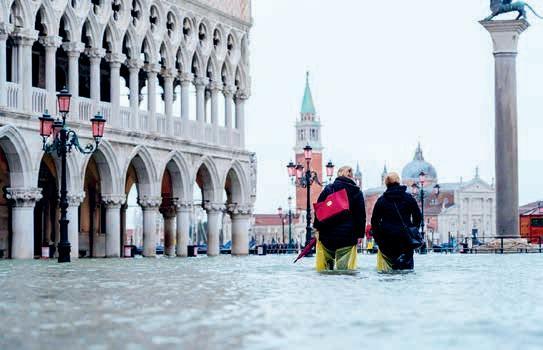
This page. Flood waters are a constant threat for the Basilica’s treasures
pect installation to be complete within the month,” the First Prosecutor continues, “and we hope that it will prove effective. In the past three years – prob ably due to climate change – flooding has become a huge problem. When it’s higher than 65 cm, then it
l’acqua alta è diventata un problema enorme. Quando supera i 65 centimetri, entra nella chiesa. Fino ai 90 centimetri, entrano in azione le pompe. Oltre – come sta accadendo ormai non di rado – occorre appunto predisporre nuove soluzioni. Sarebbe stato necessa rio intervenire con maggiore tempestività, ma, per ra gioni non certo imputabili alla Procuratoria, il sistema di protezione non è ancora completo e non possiamo dire che sia stato fatto tutto il possibile per difende re la Basilica”. Gestire un bene così prezioso e fragile significa ‘venire a patti’ con il turismo, ma anche pro muovere riflessioni e azioni concrete con le autorità preposte affinché la citta si elevi da un turismo fin troppo massificato.

“Dobbiamo conciliare due istanze opposte”, confer ma Tesserin. “La domanda turistica è abnorme, talvol ta anche da parte di persone che non hanno il dovuto rispetto per un capolavoro così delicato. Fino ad oggi l’ingresso è stato libero, ma si crea vano problemi di sovraffollamento e di disturbo dei fedeli. Per questo, seppure a malincuore, abbiamo de ciso di stabilire un costo, poco più che simbolico, di tre euro, e un li mite alle visite: non più di 500 visi tatori all’ora, secondo l’indicazione degli esperti. È stato accertato che
gets into the church. Up to 90cm, pumps can deal with it. Higher than that – as happens not infrequent ly now – new solutions have to be found. Prompter action would have been desirable, but for reasons outside the control of the Procuratoria, the protec tion system is not yet complete and we can’t yet say that everything possible has yet been done to pro tect the Basilica.”
Managing such a valuable and fragile asset means coming to terms with the visiting masses, but also working on practical projects with the relevant au thorities so that tourism in Venice can be of a higher quality than the current experience.
“We have to reconcile opposites,” Tesserin says. “Tourist demand is exceptionally high, sometimes even from people who don’t have the necessary respect for the fragility of this masterpiece. Until now, entry has been free, which has created problems of over crowding and also disturbances for the faithful. For this reason, al beit reluctantly, we have decided to charge a token fee of three euros for entry, and to impose limits: no more than 500 visitors per hour, as expert advice tells us. The pres ence of large crowds has been proved to have a damaging effect
14
Un passato splendente, un presente complesso, un futuro da scrivere oggi A splendid past, a complex present, a future to write today
una presenza massiccia provoca effetti negativi sui mosaici. Naturalmente gli incassi verranno reinvesti ti nella salvaguardia della Basilica”. Per custodire un passato glorioso e garantirgli un futuro, bisogna quin di agire nel presente. Ecco l’importanza del Premio Masi: “È l’occasione per mettere in luce la fragilità di questo ‘organismo’ unico e di rivolgere a tutti, cittadi ni e istituzioni, un appello, affinché si intervenga al più presto con strategie efficaci”. D’altra parte, è impen sabile che la Basilica di San Marco cessi per qualche ragione di essere quello che è sempre stata: croce via di culture, luogo d’incontro e accoglienza. Valga a questo proposito la riflessione conclusiva di Tesserin: “Anche dopo l’acqua alta record del 2019 e durante la pandemia, quando l’Italia intera era chiusa, il Patriarca ha voluto che, nel rispetto di tutti i criteri di sicurez za, almeno la cappella della Madonna di Nicopeia nel transetto sinistro dell’edificio rimasse aperta ai fede li: questo luogo è troppo significativo per veneziani e fedeli di tutto il mondo per renderlo inaccessibile an che solo per un giorno”.
Paolo Perazzolo, nato a Vicenza, laureato in Filosofia a Padova, ha conseguito il Master in giornalismo all’Istituto di formazione per il giornalismo di Milano. Lavora come caporedattore al settimanale Famiglia Cristiana, dove segue in particolare le tematiche culturali. È Teacher Expert in Philosophy for Children. Collabora con diverse testate e festival culturali.

Pagina precedente.
Altare della Beata Vergine Nicopeia, transetto nord della Basilica di San Marco (Per gentile concessione della Procuratoria di San Marco, Venezia)
Previous page Chapel of the Madonna Nicopeia, north transept of St Mark's Basilica (Courtesy of the Procuratoria of St Mark, Venice)
A lato. Il procuratore Barel firma la botte a nome del Primo Procuratore Carlo Alberto Tesserin
This page. Procurator Barel signs the cask in the name of First Procurator Carlo Alberto Tesserin

on the mosaics. Naturally, the proceeds will be rein vested in the maintenance of the Basilica.” To pre serve a glorious past and ensure a future, action is needed in the present.
This is why the Masi Prize is so important. “It’s an op portunity to remind people about the fragility of this unique organism and to ask everyone, citizens and in stitutions alike, to come up with effective strategies for its preservation.” It is, however, unthinkable that St. Mark’s Basilica should for some reason cease to be what it has always been: a crossroads of cultures, and a meeting place with a welcome. Tesserin underlines this thinking with his concluding comment: “Even after the record flooding of 2019 and during the pandemic, when the whole of Italy was closed, the Patriarch insisted that, safety requirements permitting, at least the chapel of Our Lady of Nicopeia in the left transept should always remain open: this place is too important for Venetians and the faithful from all over the world to close it even for one day.”
15
Paolo Perazzolo, born in Vicenza, got a degree in Philosophy from the University of Padua and Master’s degree in Journalism from the Journalists’ Training Institute in Milan. Editor-in-chief of the weekly publication Famiglia Cristiana, with focus on cultural issues. A ‘Teacher Expert in Philosophy for Children’. Collaborates with various newspapers and cultural festivals.
“Il Veneto per me è un sogno”. Uno dei due Premi Internazionale Masi Grosso d’O ro Veneziano 2022 è stato assegnato alla Great Wine Capitals, la rete mondiale di promozione dell’enotu rismo, come emblema assoluto della civiltà del vino. L’associazione, fondata a Bordeaux nel 1999 per col legare tra loro le città capitali di alcune grandi regio ni vinicole, al fine di promuovere sanità e prosperità delle attività produttive, delle comunità e del turismo legate al vino, oggi riunisce undici grandi città in tutto il mondo. Ne parliamo con il Direttore Generale Ca therine Leparmentier Dayot, presente alla cerimonia di premiazione lo scorso 14 ottobre. Come è nata questa brillante idea?
“La rete Great Wine Capitals è nata nel 1999, su iniziativa della Camera di Commercio di Bordeaux. L’idea era quella di creare collegamenti tra le città che, proprio come Bordeaux in Francia, erano una ‘capitale del vino’ nei rispettivi paesi. Da sei membri fondatori, siamo ora undici grandi metropoli che si trovano nelle mi gliori regioni vinicole del mondo, in entrambi gli emisferi, in tutti i con
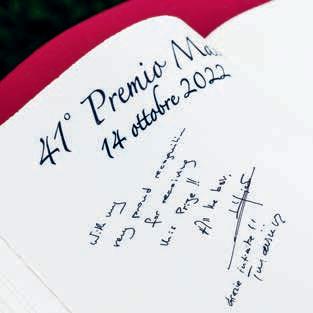
UNIRE LE CAPITALI DEL VINO NEL SEGNO DELLA SOSTENIBILITÀ E DELL’ENOTURISMO
UNITING THE CAPITALS OF WINE IN THE NAME OF SUSTAINABILITY AND WINE TOURISM
“The Veneto for me is a dream”. One of the two international Masi Grosso d’Oro Vene ziano Prizes 2022 goes to Great Wine Capitals (GWC), as an emblem of the civilization of wine and global networking to promote local wine tourism. The as sociation, which was established in Bordeaux back in 1999 to link cities connected to great wine regions together, with the aim of sustaining the health and prosperity of their wine-related industries, communi ties, and tourism, brings together eleven great cities worldwide. Le Venezie met General Manager Cath erine Leparmentier Dayot at the Masi Prize ceremony on 14th October. How did this brilliant idea start?
“The Great Wine Capitals network started in 1999, thanks to a Bor deaux Chamber of Commerce initiative. The idea was to create links between cities in the world that, just like Bordeaux in France, were a ‘wine capital’ in their own coun tries. Starting with six founding members, we are now 11 great wine capitals, major metropolises linked to some of the best wine re

16
PREMIO MASI MASI PRIZE
di Chandra Kurt Parla Catherine Leparmentier Dayot, direttore generale di Great Wine Capitals Interview with Catherine Leparmentier Dayot, Director General of Great Wine Capitals
Pagina precedente. Il libro che raccoglie le prestigiose storiche firme del Premio Masi Previous page. The autograph book with prestigiuos historic signatures from previous Masi Prize winners
La tradizionale firma della botte di Amarone nelle cantine Masi: per la Great Wine Capitals hanno firmato la direttrice Leparmentier Dayot e il vicepresidente Saenz de Buruaga
The traditional signing of the Amarone barrel in the Masi cellars: for Great Wine Capitals signatures came from Director Leparmentier Dayot and Vice-President Saenz de Buruaga
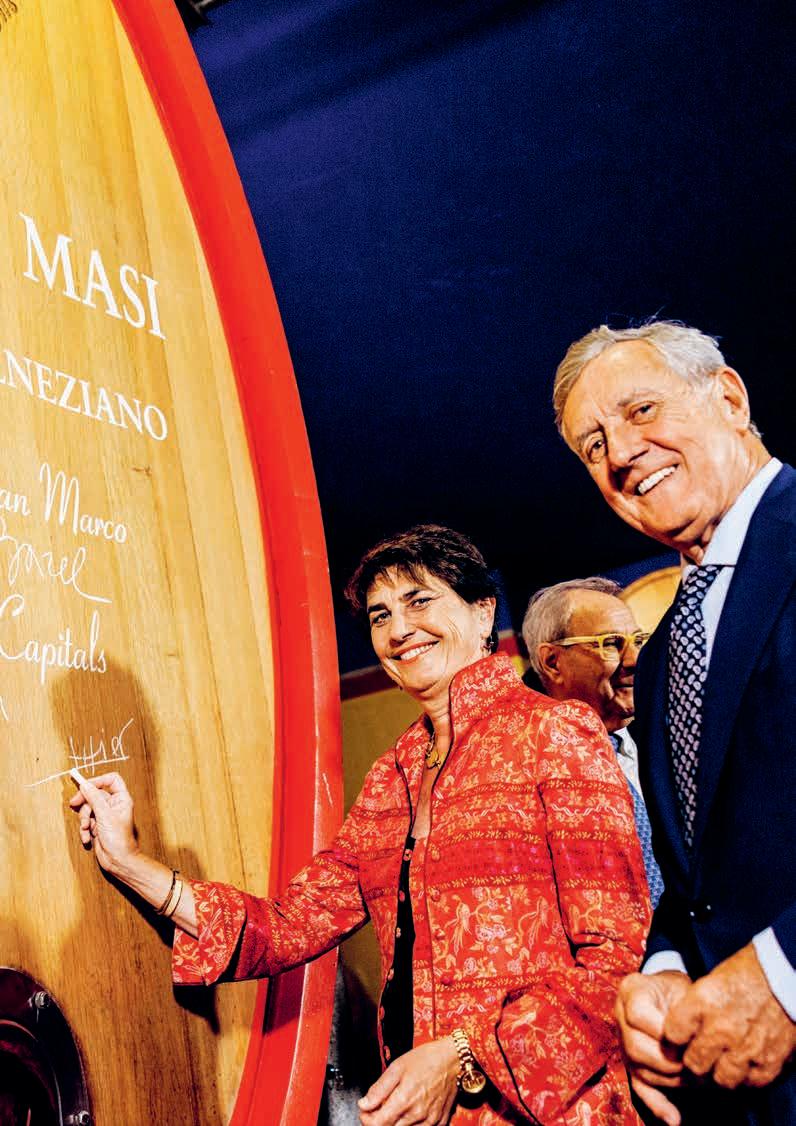
tinenti, legate da una cultura comune e universale: il vino. Operiamo unitariamente allo scopo di promuove re la salute e la prosperità delle attività produttive, del le comunità e del turismo legate al vino”.
Quali sono i criteri per la scelta di una regione?
“I nostri criteri sono piuttosto severi. In primo luo go, possiamo accettare un solo membro per Paese (‘la capitale’ del vino). Inoltre, la città candidata deve essere grande e saper offrire tutte le strutture tu ristiche: aeroporto, hotel, centri congressi, ecc. Im portante avere anche infrastrutture educative, visto che abbiamo stretti legami con scuole di business e università locali, nonché scuole professionali. Da ul timo, ma non meno importante, la città candidata deve ovviamente trovarsi in una regione vinicola ri conosciuta internazionalmente per vini con una for te immagine di ‘grandezza’ ed ‘eccellenza’ ”.
Qual è il vostro legame con il vino?
“Abbiamo forti legami con l’in dustria del vino. I comitati di rettivi di ogni città membro includono rappresentanti dell’in dustria vinicola locale. Uno dei nostri obiettivi principali è so stenere le aziende vinicole locali nello sviluppo dell’enoturismo, ma anche in tutte le sfide che
gions in the world, on both hemispheres, and on all continents, all sharing the universal culture of wine. We have come together to sustain the health and prosperity of wine related industries, communities, and tourism.”
What criteria are used in membership selection?
“Our criteria are quite strict; first, we can only ac cept one member per country (the ‘wine capital’), plus, the member city must be a major city, offering all the facilities for tourism: an airport, hotels, con gress centers, etc. The educational infrastructure is also taken into consideration as we have strong links with local business schools and universities as well as vocational schools. And last but not least the ap plicant city must obviously be situated in an interna tionally renowned wine region, producing wines with a strong image of ‘greatness’ and ‘excellence’. ”
What is your connection to wine?
Città e regioni che aderiscono devono essere rappresentative delle eccellenze di un Paese Member cities and regions must be producers of some of their nation’s best wines
“We have strong connections with the wine industry. All our local Steering Committees in each member city include wine industry representatives. One of our main objectives is to sup port our local wine businesses in the development of wine tourism but also in all the chal

18
stanno affrontando oggi, come il riscaldamento globa le, la sostenibilità e l’innovazione”. Hai una regione vinicola preferita?
“Ho 11 regioni vinicole preferite, in tutto il mondo…” Il Veneto: cosa rappresenta per te questa regione?
“Il Veneto per me è un sogno. Un insieme di storia, patrimonio culturale, luoghi meravigliosi, l’incredibile Lago di Garda, le città iconiche Venezia e Verona, una gastronomia unica e, naturalmente, i vini! È sicura mente una delle mie regioni preferite e sono sempre felice quando posso tornare a visitarla”.
Come vedi le nuove regioni vinicole che si stanno affacciando alla candidatura (Georgia, Regno Unito, Scandinavia…)?
“La Georgia è un paese che stiamo considerando se riamente. Non lo collocherei nelle ‘nuove regioni’, in quanto è riconosciuta come la culla della civiltà del vino con un background viticolo antichissimo. La loro apertura al mondo è tuttavia più recente e da quello che vedo io, stanno imparando velocemente e stanno crescendo nella giusta direzione. È molto interessante ciò che sta succedendo nel Regno Unito, in particolare nella regione del Kent, dove alcuni famosi pro duttori francesi di Champagne
Pagina precedente
Un momento dell’applaudito talk show con i premiati Previous page. The popular talk show and Prize-winning guests
A lato. Giovani wine lovers in visita nei vigneti Masi Tupungato nell’area di Mendoza, una delle grandi capitali mondiali del vino This page. Young wine lovers visiting Masi Tupungato vineyards in Mendoza, one of the Great Wine Capitals of the world
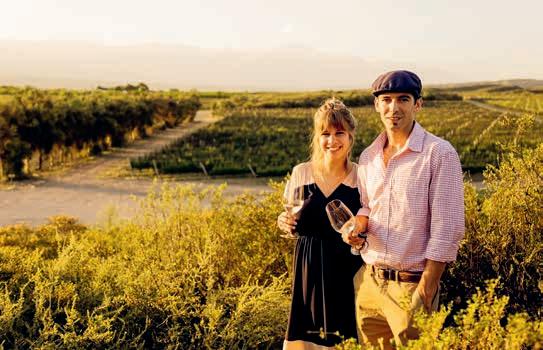
lenges they are facing, like global warming, sustain ability, and innovation.” Do you have a favorite wine region?
“I have 11 favorite wine regions, all around the world…” The Veneto – what does this region mean to you?
“The Veneto for me is a dream. A blend of history, heritage, beautiful places, the amazing Lake Garda, the iconic cities of Venice and Verona, unique gas tronomy, and of course the wines! It’s certainly one of my favorite parts of the world and I’m always hap py when I can go back and visit.”
How do you address applications for membership from new wine regions (Georgia, Regno Unito, Scan dinavia…)?
Il Grosso d’Oro Veneziano al network formato da undici regioni
The Grosso d’Oro Veneziano goes to a network of eleven wine regions
“Georgia is a country we are looking at seriously. I wouldn’t place it in the ‘new wine regions’ category as it is recognized as the cradle of wine civilization with a very ancient viticultural background. Their open ing up to the world is, however, more recent and from what I see, they are learning fast and grow ing in the right direction. What’s happening in UK nowadays is very interesting, particularly in the Kent region, where famous French Champagne producers have been planting vines for sev
19
piantano viti ormai da diversi anni. Non sono ancora sicura del poten ziale scandinavo ma, comunque, potrebbe volerci del tempo prima che la loro produzione raggiunga i nostri standard di eccellenza. Intan to, continuiamo tenerla d’occhio!”
Le regioni vinicole in generale sono ben attrezzate per il turismo?
Sul tavolo tre nuove candidature: Regno Unito, Scandinavia e Georgia
Three new candidates in the offing: United Kingdom, Scandinavia and Georgia
“Le nostre Grandi Capitali del Vino sono molto ben at trezzate per il turismo in generale. È proprio un criterio di base per l’adesione. Ma sono anche tra le regioni più attrezzate in termini di enoturismo. Grazie alla nostra rete, le città partner e le regioni vinicole hanno facile accesso alle migliori procedure, consentendo uno svi luppo più rapido e sostenibile. Continuiamo a progre dire insieme, attraverso l’innovazione condivisa. Il no stro Concorso internazionale ‘Best of Wine Tourism’, giunto alla sua 20ª edizione, è un esempio di un pro gramma forte e di successo che sostiene la struttura zione del settore, supporta l’innovazione e promuove a livello globale le cantine e gli operatori turistici locali”. C’è una fecondazione incrociata tra le regioni?
“Certamente! Come rete, ci scambiamo buone prati che, know-how e competenze. Facilitiamo le presenta zioni, incoraggiamo le collaborazioni. La nostra forza è la nostra intelligenza collettiva al servizio dello sviluppo e del business locali”.
eral years now. I’m not sure about the Scandinavian potential yet; but anyhow, it may take time be fore their production reaches our standards of excellence. But we’ll keep on looking…!’
Are wine regions in general well equipped for tourism?
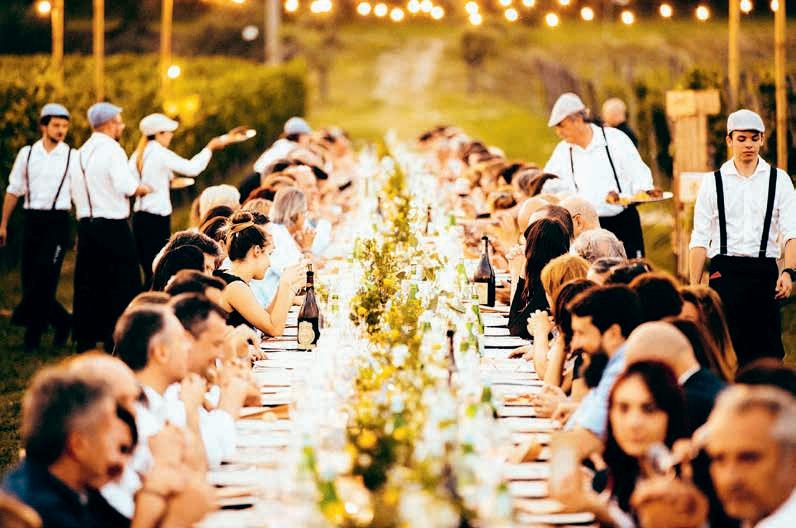
“Our Great Wine Capitals are very well equipped for tourism. It is, after all, a criterion for member ship. But they are also among the best equipped re gions in terms of wine tourism. Thanks to the GWC, member cities and wine regions have easy access to the best practices, enabling quicker and more sus tainable development. We make progress together, through shared innovation. Our international ‘Best of Wine Tourism’ contest, now in its 20th edition, is an example of a strong and successful program sustaining the structure of the sector, supporting in novation, and promoting local wineries and tourism operators globally.”
Is there a cross fertilization between regions? “Certainly! As a Network, we exchange good prac tices, know-how and expertise. We facilitate intro ductions, we encourage collaborations. Our strength is our collective expertise used in support of local de velopment and businesses.”
How are regions promoted through you?
Le Great Wine Capitals promuovono sinergie per lo sviluppo sostenibile dell’enoturismo tra le 11 capitali del vino. In foto: nella provincia di Verona Capitale del Vino, un evento a Masi Tenuta Canova, sul lago di Garda
The Great Wine Capitals plans synergies for the sustainable development of wine tourism in 11 wine capitals. Photo: an event at Masi Tenuta Canova, near Lake Garda, in the province of Wine Capital Verona
Com’è la promozione di una regione scelta?
“Uno degli obiettivi principali è promuovere i nostri soci come destinazioni enologiche di eccellenza. Stia mo promuovendo ciascuna città sul nostro sito web, ma abbiamo anche attività quotidiane su tutti i social media. Inoltre, abbiamo sviluppato una strategia di marketing diretto, condividendo le informazioni con i nostri diversi tipi di pubblico attraverso newsletter personalizzate, permettendo di promuovere la nostra destinazione presso il grande pubblico o verso diversi target professionali, mettendo in evidenza gli opera tori locali, le cantine e i servizi a disposizione”. Una nota personale: qual è il tuo vino preferito?
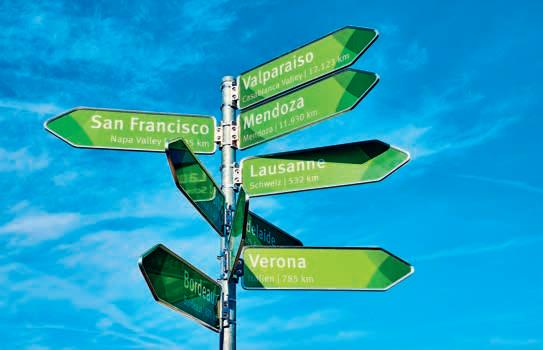
“Amo i vini bianchi secchi, potrei quindi scegliere un Pessac-Léognan di Bordeaux, o un Mendocino Tor rontes, un Sauvignon blanc cileno, un Viura della Rioja, un Chasselas di Losanna, un Riesling Rheinhessen, un Soave del Veneto, uno Chardonnay di Napa, un Se millon del South Australia, un Viognier di Cape Wine lands in Sud Africa o un bianco di Porto… scegli tu!”
“One of our major objectives is to promote our members as wine destinations of excellence; we promote each of them on our website, but we also have daily activities on all social media; we have also developed a direct marketing strategy, sharing infor mation with our different audiences through per sonalized newsletters. These allow us to promote our destinations to the general public, or to various professional targets, highlighting the local tourist operators, the wineries, and the services that are available.”
On a personal note: what is your favorite wine?
“I’m fond of dry white wines, so my choice would be either a Pessac-Léognan from Bordeaux, a Mendo cino Torrontes, a Chilean Sauvignon blanc, a Viura from Rioja, a Chasselas from Lausanne, a Rheinhessen Riesling, a Soave from the Veneto, a Chardonnay from Napa, a Semillon from South Australia, a Viognier from the Cape Winelands in South Africa, or a white Port… take your pick!”
Chandra Kurt, vive a Zurigo, è una delle più importanti scrittrici di vino della Svizzera, autrice di oltre venti libri. Dopo un’infanzia in Asia, studia scienze politiche all’università di Zurigo e Losanna, si diploma all’Institute of Masters of Wine di Londra. Collabora a numerose pubblicazioni e nel 2015 lancia la sua rivista sul vino ‘Weinseller Journal’.
Chandra Kurt, based in Zurich, is one of Switzerland’s foremost wine writers, authoring more than twenty books on wine. After her childhood in Asia, she studied political science at the Universities of Zurich and Lausanne and at the Institute of Masters of Wine in London. Chandra contributes to various publications, and in 2015 launched her own wine magazine ‘Weinseller Journal’.

21
MONTELEONE21: LA PORTA D’ENTRATA NELLA VALPOLICELLA DEL DOMANI MONTELEONE21: TOMORROW’S ENTRY GATE FOR VALPOLICELLA
a cura della Redazione
Il centro polifunzionale Masi, motore del turismo esperienziale sul territorio Masi’s multifaceted center, the motor for experiential tourism in the region
Proiettato nel futuro, con le radici saldamente ancora te nel passato: è l’immagine che restituisce ‘Monteleo ne21’ a Gargagnago di Valpolicella, il nuovo complesso polifunzionale di Masi Agricola che è stato presentato in anteprima agli ospiti delle celebrazioni della 250ª vendemmia della famiglia Boscaini e del 41° Premio Masi, che si sono svolte il 14 ottobre scorso in un uni co grande evento di respiro internazionale. I lavori saranno terminati nella tarda primavera dell’anno prossimo, ma già si intuisce l’inscindibile lega me tra passato, presente e futuro che caratterizza l’opera nata dall’originario progetto dell’architetto Li bero Cecchini, sviluppato dal figlio Vittorio e dal co progettista, l’architetto veneziano Giovanna Mar che lo sta realizzando assieme all’architetto Alessandro Beghini. Il nuovo edificio polifunzionale nasce per es sere un ideale entry gate della Valpolicella Classica, a vantaggio del territorio: è con questo spi rito che l’azienda Masi e la fami glia Boscaini, giunta all’ottava ge nerazione, affrontano l’iniziativa finalizzata a intercettare il turi smo che gravita su Verona e il lago di Garda per facilitarne l’ac
Designed for the future, with its roots firmly an chored in the past: this is how ‘Monteleone21’ in Gar gagnago di Valpolicella presents itself. Masi Agricola ’s new multifunctional complex was shown in preview to guests at celebrations of the Boscaini family’s 250th grape harvest and the 41st Masi Prize in a singular event of international propor tions on 14 October.
Federico Girotto: “Sarà anche un’infrastruttura culturale per potenziare l’enoturismo”

Federico Girotto: “This centre will be cultural infrastructure to power wine tourism”
Building work will be completed in late spring next year, but the indissoluble link between past, present and future can already be sensed in the unique de sign, planned by architect Libero Cecchini and devel oped by his son Vittorio, with co-designer architect Giovanna Mar from Venice, who is carrying out the building work together with architect Alessandro Beghini. The new multipurpose building was created to be a sort of ‘entry gate’ to Valpolicella Classica, benefit ing the whole region. This is the spirit that the Masi winery and the Boscaini family, now in its eighth generation, are using to take advantage of the tourism that gravitates to Verona and Lake Garda by providing ac
22
Pagina precedente
Federico Girotto, amministratore delegato, e Sandro Boscaini, presidente di Masi Previous page. Federico Girotto, Managing Director, and Sandro Boscaini, President of Masi ‘Monteleone21’, il complesso polifunzionale sarà completato nel 2023. In foto: il fruttaio allestito per l’evento, sarà poi dedicato alle tradizionali arele per l’appassimento delle uve ‘Monteleone21’, a multifaceted complex that will be completed in 2023. Photo: the fruttaio dressed for the occasion – soon to be filled with the traditional arele used for grape ‘appassimento’

cesso alla Valpolicella. Un progetto che si avvale an che di studi preparatori sui flussi turistici commissio nati alla IULM di Milano. Il presidente del Gruppo Masi, Sandro Boscaini, ha definito Monteleone21 come “espressione della vocazione del nostro territorio ad essere luogo di turismo esperienziale, centro per i vi sitatori ma soprattutto un’infrastruttura culturale per potenziare l’enoturismo. A 250 anni dalla nostra prima vendemmia ci emoziona presentare questo progetto, che racchiude in sé i principali valori del marchio Masi e ne rappresenta la storia, il presente e il futuro. La
cess to Valpolicella. The project also benefits from preparatory studies on tourist flows commissioned from the IULM of Milan. The President of the Masi Group, Sandro Boscaini, defines Monteleone21 as “proof of the suitability of our region as a place for experiential tourism: a visitor centre, yes, but above all a place of culture designed to boost wine tourism. 250 years after our first har vest, we are excited to launch this project, which en capsulates the primary values of the Masi brand and recounts its past, present and future. The new struc

nuova struttura sarà collegata da un lungo passaggio ipogeo alla storica sede e alla cantina di Gargagnago, borgo dell’Amarone. Saranno attivati percorsi espe rienziali, vi si svolgeranno eventi e mostre, ci saran no sale di degustazione, la possibilità di apprezzare i vini in abbinamento alla cucina locale e di acquistare i prodotti. La struttura sarà disponibile anche per con vegni o iniziative promosse dal territorio”.
‘Monteleone21’ prende il nome sia dal piccolo colle dove sorge (che si chiama appunto Monteleone), sia dall’iconico Leone di San Marco, simbolo delle Tre Ve
ture will be connected to Masi’s historic headquarters and winery in Amarone’s home town of Gargagnago by an extensive underground passageway. Wine expe riences, events and exhibitions will be held here; there will be tasting rooms, and the chance to try wines paired with local food, and buy them. The building will also be available for local conferences or events held by public bodies.”
Monteleone21 takes its name from the small hill where it stands (called Monteleone) and from the iconic Lion of St Mark, the symbol of the Tre Ven
 Il fruttaio monumentale, alto ben 12 metri, costituirà anche un’attrattiva esperienziale per i visitatori The imposing fruttaio, more than 12 m high, will also add to the attraction for Wine Experience visitors (render by Studio Architetti Mar)
Il fruttaio monumentale, alto ben 12 metri, costituirà anche un’attrattiva esperienziale per i visitatori The imposing fruttaio, more than 12 m high, will also add to the attraction for Wine Experience visitors (render by Studio Architetti Mar)
nezie, nonché da una leggenda locale che narra della testa di un leone d’oro che sarebbe stata sepolta an ticamente in questo luogo. Una sorta di collinetta er bosa, con una forma sopra terra caratterizzata sul lato sud da un rivestimento in pietra locale, a evocare la suggestione delle marogne, i tipici muretti a secco che sostengono i vigneti di collina in Valpolicella: così apparirà l’edificio, che sarà realizzato per due terzi in ipogeo, sarà coperto di viti e altra vegetazione per una perfetta integrazione con il paesaggio circostante.

ezie region, as well as from a local legend about a golden lion head that was supposedly buried here in ancient times. A sort of grassy knoll, with a shape above-ground on the south side made of local stone, in a reference to the traditional marogne dry-stone walls that buttress hillside vineyards in Valpolicella. This is what the building, two-thirds of which will be underground, will look like, covered with vines and other vegetation for perfect integration with the sur rounding landscape.

Progettazione, design e materiali rispettano una sostenibilità ambientale e paesaggistica: gli esterni rivestiti in pietra locale, ispirati ai tipici muri a secco (marogne), la suggestiva Agorà centrale che riceve luce naturale, gli spazi che ospiteranno un Masi wine bar, un wine shop, sale degustazione e spazi operativi aperti ad eventi culturali Planning, design and materials respect sustainability for the environment and the landscape. Exteriors are clad in local stone, inspired by the region’s typical dry-stone walls (marogne); the striking central Agorà is full of natural light, other parts will house a Masi wine bar, a wine shop, tasting rooms and spaces for cultural events
“All’interno – spiega l’amministratore delegato Federi co Girotto – ci sono due spazi suggestivi: un’agorà di forma circolare, con un soffitto a cassettoni in calce struzzo che reinterpreta le suggestioni delle grandi ar chitetture e opere di ingegneria italiane anni ’50 e ’60, che rappresenterà poi il centro delle attività legate alla ricettività enoturistica. E un fruttaio monumentale, destinato all’appassimento delle uve per l’Amarone, di dodici metri in altezza, che, seppure pensato per la produzione, costituirà anche un’attrattiva esperienzia le e un tributo all’originalità del nostro grande vino”.
Per ‘Monteleone21’ le soluzioni adottate sono all’inse gna della sostenibilità: dall’utilizzo di fonti rinnovabili come il fotovoltaico e la geotermia, alla minimizzazio ne dei consumi energetici, per esempio con la crossventilation.
La struttura in fase di completamento sarà aperta al pubblico il prossimo anno, è concepita come un ulte riore tassello del progetto ‘Masi Wine Experience’, che punta a coinvolgere in modo diretto il consumatore nell’enoturismo, come già avviene in Valpolicella clas sica nella sede di Masi Agricola e nella Tenuta Serego Alighieri con la Foresteria di Gargagnago, a Lazise con Tenuta Canova, a Valdobbiadene con Canevel Spuman ti, e con i ‘Masi Wine Bar’ a Cortina d’Ampezzo sulle Dolomiti, nel cuore pulsante di Monaco di Baviera e a Mendoza, in Argentina, nella Tenuta Masi Tupungato.
“Inside, – explains Managing Director Federico Gi rotto – there are two imposing spaces: a circularshaped agorà, with a concrete coffered ceiling that has references to the great Italian architectural and engineering works of the 1950s and 1960s, which will be the reception centre for activities related to wine tourism. And a monumental fruttaio, twelve metres in height. Used for the drying of grapes for Amarone and designed for production purposes, this will also be an attraction in the Wine Experi ence circuit and a tribute to the originality of our great wine.”
Monteleone21 is built in the name of sustainability, from the use of renewable sources such as photo voltaics and geothermal energy, to the minimisation of energy consumption, for example with cross-ven tilation. The structure, which is nearing completion and will be open to the public next year, is part of the ‘Masi Wine Experience’ project, which aims to involve consumers in wine tourism directly. This already happens in Valpolicella Classica with Masi Agricola and at Tenuta Serego Alighieri with the Fo resteria di Gargagnago. It also happens in Lazise with Tenuta Canova, in Valdobbiadene with Canevel Spu manti, with the ‘Masi Wine Bars’ in Cortina d’Ampezzo in the Dolomites and in the heart of Munich, and at Tenuta Masi Tupungato in Mendoza, Argentina.
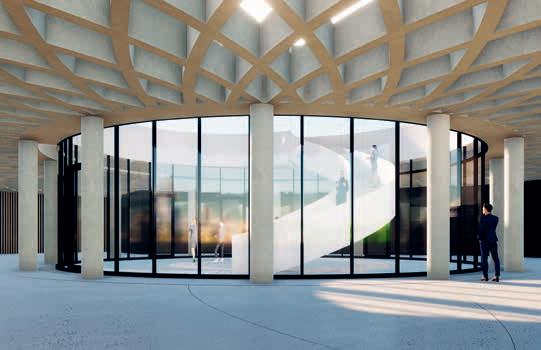
27
EVENTI
SENZA FRONTIERE PER I 250 ANNI EVENTS ABROAD TO CELEBRATE 250 YEARS
a cura della Redazione
Una celebrazione condivisa con la grande rete di collaboratori e amici Celebrations shared with a wide network of partners and friends
Londra, Monaco di Baviera, Dublino, Stoccolma, Rey kjavik, Oslo, Helsinki, Zurigo, Vienna, Bruxelles, Am sterdam e poi Québec in Canada, Taipei in Taiwan, Sai gon e Hanoi in Vietnam, Shanghai in Cina, Giappone… Non solo Italia, dunque, ma in linea con la propria pro iezione internazionale, Masi ha voluto celebrare i suoi 250 anni anche fuori dai confini italiani con una serie di eventi finalizzati a condividere con il proprio trade, autorità locali, giornalisti e consumer la soddisfazione per l’importante traguardo raggiunto e per consolida re in prospettiva futura i reciproci legami di amicizia e collaborazione. A farsi ambasciatori del brand all’este ro sono stati in particolare Raffaele Boscaini, direttore marketing di Masi Agricola e coordinatore del Gruppo Tecnico Masi, e Giacomo Boscaini, brand ambassador, entrambi rap presentanti della settima generazio ne della famiglia.
“La celebrazione delle 250 vendem mie è stata un’ulteriore occasione per constatare il grande valore del la nostra filiera”, spiega Raffaele Boscaini tra una tappa e l’altra della maratona di eventi. “Una filiera che si esprime a valle della produzione e
London, Munich, Dublin, Stockholm, Reykjavik, Oslo, Helsinki, Zürich, Vienna, Brussels, Amsterdam and then Québec in Canada, Taipei in Taiwan, Saigon and Hanoi in Vietnam, China, Japan…
Not only Italy, then, but in line with its international presence, Masi also decided to celebrate its 250th an niversary outside Italy with a series of events aimed at sharing the important milestone and consolidating mutual ties of friendship and business relations in the future with its importers, with local authorities, jour nalists and consumers.
Representing Masi abroad were Raffaele Boscaini, Marketing Director of Masi Agricola and Coordinator of the Masi Technical Group, and Giacomo Boscaini, Brand Ambassador, both part of the seventh generation of the family.
Un calendario di serate in location prestigiose disegnate intorno al brand e alla sua storia A calendar of evenings in prestigious locations with themes taken from the brand and its history
“The celebration of 250 vintages was another opportunity to ap preciate the great value of the me chanics of our export market,” ex plains Raffaele Boscaini, in a break between one event and another on his marathon trip. “There is a fascinating multiplicity of rela tionships at all levels in our supply

28
Norvegia
Norvegia
Lo straordinario
dei Masi 1997, prodot to in sole 2.500 magnum, è stato stappato in una serie di eventi glamour e degustazioni esclusive in Italia e all’Estero organizzate dai nostri partner commerciali. In foto: Giacomo Boscaini a Dublino
The extraordinary Vajo dei Masi 1997, pro duced in just 2,500 magnums, was uncorked at a series of glamorous and exclusive events and tastings in Italy and abroad organised by our commercial partners.
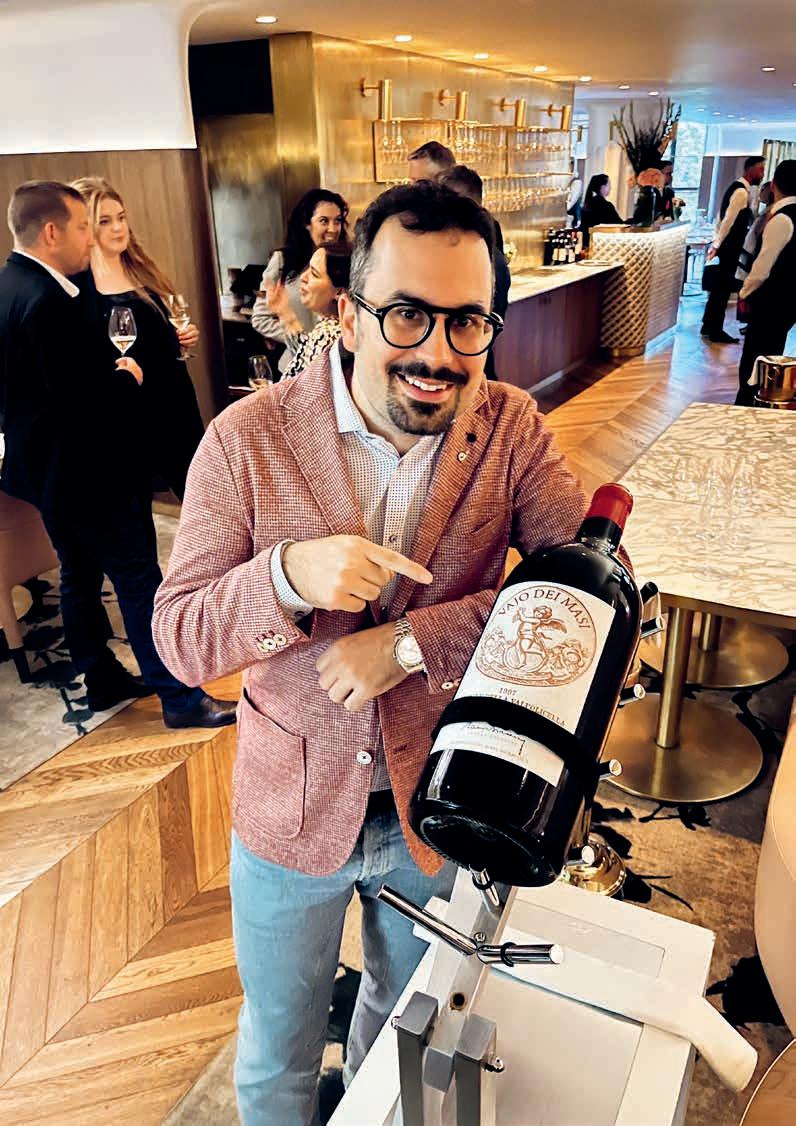 Vajo
Photo: Giacomo Boscaini in Dublin
Vajo
Photo: Giacomo Boscaini in Dublin


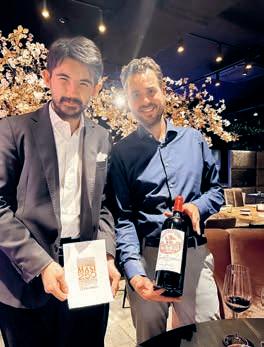


 Austria
Finlandia
Belgio Islanda Svizzera
Svezia
Austria
Finlandia
Belgio Islanda Svizzera
Svezia

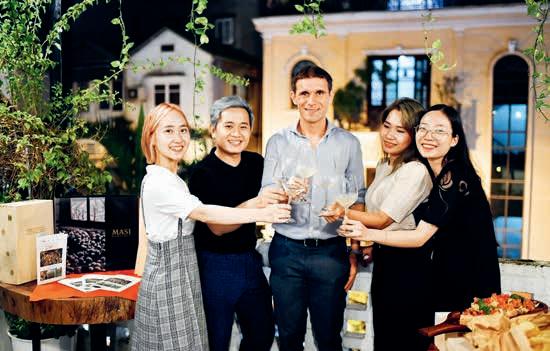
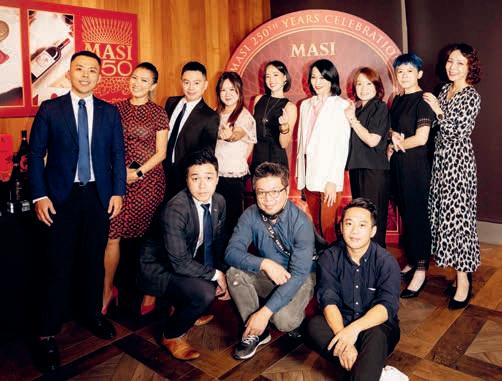

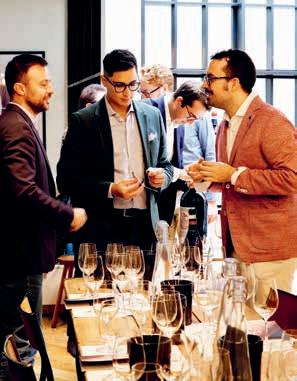
Inghilterra
Taiwan
Germania
Hanoi, Vietnam Irlanda
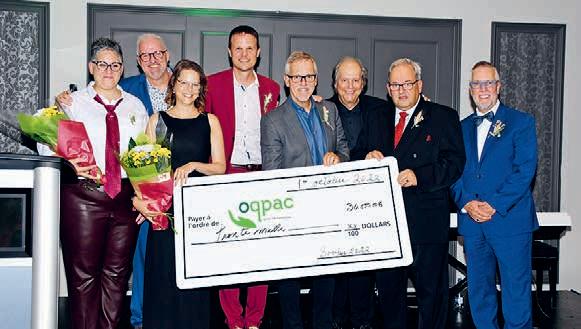
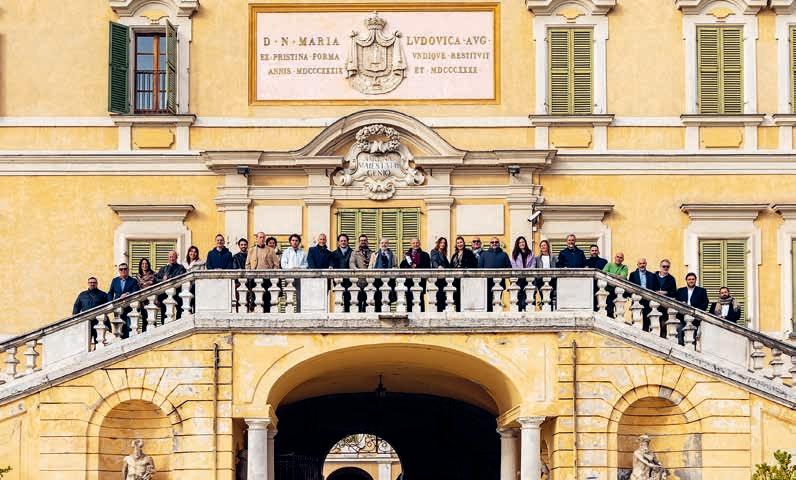

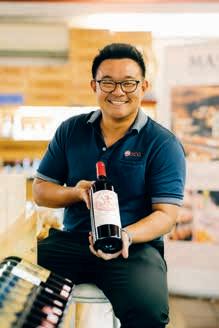
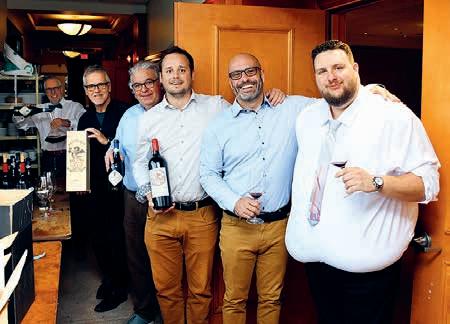 Olanda Canada, Québec
Saigon, Vietnam
Canada, Québec
Italia
Olanda Canada, Québec
Saigon, Vietnam
Canada, Québec
Italia
che è contraddistinta da un’affascinante molteplicità di relazioni, anche di lungo corso, con aziende di distri buzione, con buyer e clienti fino ai consumatori. Tutte figure con cui negli anni abbiamo creato una dinami ca virtuosa che consente al nostro marchio di essere ‘di casa’ anche in luoghi geograficamente e cultural mente distanti dalla Valpolicella. Sono stati gli attori di questa filiera – continua il direttore marketing – a pro digarsi per organizzare in modo singolare eventi che in poche ore, potessero far sintesi di tutti i valori e i significati che una storia così lunga può consegnarci”. Il risultato è un calendario di serate in location presti giose “disegnate intorno al brand e alla sua storia, de clinate secondo la diversa sensibilità dei vari mercati ma tutte assolutamente contraddistinte da un’evidente autenticità e senso di condivisione. I volti meravigliati, appagati e sereni di chi era presente, sono stati il chia ro indice della bontà del nostro messaggio e, mi viene da dire, di una sua universalità”.
Il tour delle celebrazioni conti nuerà sia all’estero che in Italia, coinvolgendo alcune tra le prin cipali città italiane Milano, Parma, Roma, Napoli, Venezia e Cortina, presso il Masi Wine Bar Al Dru sciè, aperto nel 2019 sulle piste olimpiche della Tofana.

Norvegia
Pagina precedente.
Evento speciale anche presso ALMA (Parma), l’alta scuola internazionale di cucina e ospitalità italiana. L’esclusiva serata a Québec (Canada) ha avuto anche uno scopo benefico (una raccolta fondi per i malati di cancro)
Previous page. A special event was also held at ALMA (Parma), the international high school of Italian cuisine and hospitality. In Québec (Canada) the celebratory evening also had a charitable purpose (fundraising for cancer patients)
chain, some of them very long-standing, with distri bution companies, buyers and clients right up to the consumer level. All people with whom we have cre ated a virtuous dynamic over the years that means our brand can be ‘at home’ even in places that are geographically and culturally a long way from Valpo licella. These same people,” continues the Marketing Director, “have done their utmost to organise events that have succeeded in celebrating the value of our long history together.”
The result was a series of evening events in prestig ious locations “designed around the brand and its history, formulated according to the various pref erences of individual markets, but all very genuine with a real sense of shared pleasure. The amazed, delighted and happy faces of those who were pre sent were a clear indication of the worth of our brand positioning and, I would say, of its universal appeal.” The programme of cel ebrations continues, both abroad and in Italy. Major Italian cities, such as Milan, Parma, Rome, Na ples, and Venice are involved, plus Cortina, where events take place at the Masi Wine Bar Al Drusciè, opened in 2019 on the Tofana Olympic slopes.
33
Occasioni per constatare il grande valore della filiera di tutto il gruppo Opportunities to affirm the value of the distribution chain for the whole group
MASI, PIONIERI ANCHE NELLA COMUNICAZIONE MASI, PIONEERS IN COMMUNICATION, TOO
di Fabio Piccoli
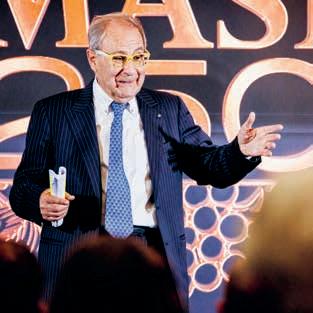
Da sempre innovativi nel saper raccontare il binomio vino e cultura
Always innovative in knowing how to talk about the link between wine and culture
Per chi, come il sottoscritto, si occupa di comunica zione del vino da oltre trent’anni, Masi ha rappresen tato un costante punto di riferimento. Se c’è stata un’impresa che è riuscita più di altre a raccontare con estrema autenticità e autorevolezza non solo la pro pria identità produttiva ma anche la cultura che ruo ta attorno al mondo del vino questa è, senza ombra di dubbio, l’azienda Masi. Quante volte, infatti, abbia mo sentito parlare dell’importanza del binomio vino e cultura, vino e territorio di produzione, ma anche vino e made in Italy in tutte le sue diverse declinazio ni. Masi è riuscita a tradurre concretamente queste relazioni in una comunicazione di straordinaria effi cacia, anticipando pionieristicamente i tempi. Provate solo ad immaginare quale sarebbe stato il destino dell’Amarone senza un brand come Masi che è riusci to ad accreditare il grande rosso della Valpolicella in tanti merca ti, a partire dal Nord America e dai paesi scandinavi, già dai primi anni ’70. Basta andare a rivedere le campagne pubblicitarie fatte su Wine Spectator a metà degli anni ‘80 dove il Campofiorin e il Costa
Autenticità e credibilità: questo il cuore del messaggio che l’impresa ha voluto trasmettere Authenticity and credibility: the heart of the message the company aims to communicate
For those who, like myself, have been involved in wine communication for over thirty years, Masi has been a constant point of reference. If there is one company that has succeeded more than others in telling us the story not only of its own identity, but also of the culture of the world of wine, with ex treme authenticity and authority, it is undoubtedly Masi. How many times, in fact, have we heard of the importance of the pairing of wine and culture, wine and its region of origin, and also wine and Ital ian products in all their various declinations. Masi has managed to realistically translate these rela tionships into extraordinarily effective communica tion programmes, far in advance of their times. Just imagine what the reputation of Amarone would have been with out a brand like Masi, which has managed to communicate the value of Valpolicella’s great red wine on so many markets, start ing with North America and the Scandinavian countries, since the early 1970s. It’s enough just to look back at the advertising cam paigns in Wine Spectator in the
34
Fare vino è arte, cultura e musica (Campagna ADV, 2014)
Making wine is art, culture and music (advertisement campaign, 2014)

sera venivano raccontati come “the prince and the king of the royal family of Venetian wines”.

L’esaltazione del legame con il Veneto e con Venezia è stata una delle scelte più visionarie della comunica zione dei vini della regione. Qualcuno, erroneamente a mio parere, intravvedeva in quella scelta il volersi allontanare dalla Valpolicella, in realtà ha rappresen tato la modalità più efficace per evidenziare a livel lo internazionale la relazione straordinaria tra una grande azienda veneta e il suo ampio terroir storico, viticolo e culturale. Una comunicazione che ha allar gato la visuale del target internazionale più autore vole ad una terra come la Valpo licella, a due vini incredibili come l’Amarone e il Ripasso, grandi figli di questa civiltà veneta.
Ampliare le proprie radici alle tre Venezie è stata un’intuizione genia le che non solo ha aiutato l’azienda ad aumentare la sua notorietà in tutto il mondo, ma ha dato un con tributo decisivo per accreditare la Valpolicella tra le grandi terre del vino. Ed è sempre da queste radici che nasce, nei primi anni ’80 quello che possiamo considerare tutt’oggi l’evento culturale più autorevole e
mid-1980s where Campofiorin and Costasera are de scribed as ‘the prince and the king of the royal fam ily of Venetian wines’. The emphasis put on the link with the Veneto and Venice was one of the most visionary choices in Ma si’s communication about its wines. Some, mistakenly in my opinion, saw in that choice a desire to move away from Valpolicella, but actually it succeeded in highlighting at international level the extraordinary relationship between a great Veneto winery and its vast historical, viticultural and cultural terroir. This was a message that broadened international perspec tives on Valpolicella as a region and on the two amazing wines, Amar one and Ripasso, that are the off spring of tradition in the Veneto. Again, extending the company’s roots to the Tre Venezie – the Three Venetias, or Venetian regions – was a clever idea that both helped the company become better known at an international level, and brought Valpolicella to fame as one of the world’s great wine regions. And it is also from these roots that, in the early 1980s, what is still the most authoritative and internationally
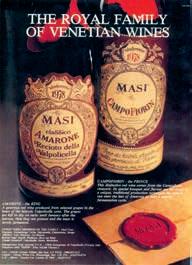
36
riconosciuto a livello mondiale, ideato e organizzato da un’impresa vitivinicola: il ‘Premio Masi’. Dal 2001 è affidato alla Fondazione Masi, istituita allo scopo di valorizzare il territorio, la popolazione, il patrimonio culturale, le grandi capacità dell’ingegno e produtti ve della civiltà veneta e della civiltà del vino. Se solo penso alle personalità che il Premio ha permesso di conoscere ad un semplice giornalista del vino come il sottoscritto, ha dell’incredibile. Le più alte intelligen ze, personaggi di vari mondi e settori, sono arrivate a San Giorgio Ingannapoltron in Valpolicella e nella nostra bella Verona grazie a questo riconoscimento, quando ancora pochi si rendevano conto dell’op portunità di legare il vino alle eccel lenze dell’economia, dell’arte, dello spettacolo, della cultura generate nel nostro territorio.
Ma l’anima pionieristica dell’azien da in termini di comunicazione non finisce qui. È stata infatti tra le primissime realtà vitivinicole del nostro Paese a comprendere l’im portanza di legare il vino al mon do del luxury, comunicandolo con un’eleganza unica, capace di iden tificare nel brand tutti quei valori
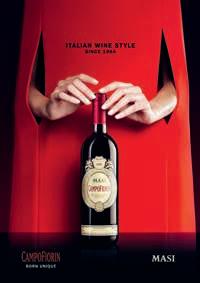
Pagina precedente, sopra Costasera Contemporary Art 2019, opera dell’artista He-Xi, Cina. Sotto. Campagna stampa negli USA a metà anni ’80
Previous page, above Costasera Contemporary Art 2019, work by artist He-Xi, China. Above. Press campaign in USA in the mid-’80s
A lato. Costasera Contemporary Art 2021, murales dell’artista Misha Libertee, Russia. Sotto Campofiorin incarna lo stile del vino italiano nel mondo (2018)
This page. Costasera Contemporary Art 2021, murals by artist Misha Libertee, Russia. Below. Campofiorin is an international icon of Italian style (2018)
recognised cultural event conceived and organised by a winery, was born: the ‘Masi Prize’. Since 2001, the Prize has been under the tutelage of the Masi Foun dation; its aim being the promotion of the region, the people, the cultural heritage, business acumen and professional skills of the Veneto and the world of wine. If I just think of the personalities that a simple wine journalist like myself has come to know through the Prize, it is incredible. The most able people from all walks of life have come to San Giorgio Ingannapol tron in Valpolicella and to the beautiful city of Verona thanks to this award, when few people yet realised that there was an opportunity to link wine to the finest aspects of business, the arts, entertainment and culture gener ated in our area.
But the company’s pioneering spirit in terms of public relations does not finish there. In fact, Masi was one of the very first wineries in Italy to understand the impor tance of linking wine to the world of luxury, putting the message across with a unique elegance and identifying in the brand all those ‘Italian’ values that the world

37
del made in Italy che il mondo ci riconosce, ma che raramente le nostre aziende riescono a manifestare in maniera adeguata. Masi ci è riuscita grazie alla col laborazione con le migliori agenzie internazionali in questo campo, come la Armando Testa e il McCann Worldgroup che hanno contribuito ad orientare il
recognises, but that other Italian companies rarely manage to communicate successfully. Masi has suc ceeded thanks to working with the best international agencies in the field, such as Armando Testa and the McCann Worldgroup, which have helped direct the brand towards the best environment for multifac
Il futuro del bere giovane è il progetto ‘Fresco di Masi’ (2021)
The future for drinking for young people is the ‘Fresco di Masi’ project (2021)

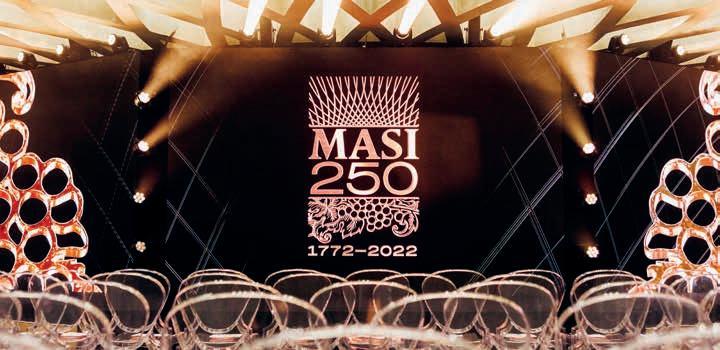
Pagina precedente. Il logo celebrativo incarna le strategie attuali e l’eredità storica-culturale-viticola
Previous page
The celebratory logo encapsulates current strategies and the historical-culturalvinous heritage
A lato. Progetti di successo rivolti al consumatore finale: Masi Wine Experience e i Masi Wine Bar. Sotto. Il successo editoriale del libro di Kate Singleton Mister Amarone edito in inglese e italiano

This page. Successful projects aimed at consumers: Masi Wine Experience and Masi Wine Bars. Below. Publishing success with Kate Singleton’s book Mister Amarone, in English and in Italian
marchio e i suoi vini verso l’habitat migliore per una comunicazione multiforme: il lifestyle. Attraverso il li festyle, infatti, è penetrata in ambienti non usuali per il vino, riuscendo a coniugare valori materiali e imma teriali. Un mix di contenuti comunicativi che consen tono a Masi di raggiungere l’obiettivo più importante per un’impresa, in particolare per una realtà vitivini cola: essere autentica e credibile. In questa direzione non si può non evidenziare il grande contributo dato da Sandro Boscaini che prima di altri ha compreso l’importanza del ‘metterci la faccia’, del non nascon dersi dietro i propri vini, ma di essere sempre tra sparenti e testimoniare in prima persona la propria filosofia produttiva, il proprio credo, sfuggendo sempre dai luoghi comuni. Solo così poteva nascere il mito di ‘Mister Amarone’, appellativo che ri conosce un lungo percorso contrasse gnato da coraggio produttivo, grande capacità imprenditoriale e straordina ria visione comunicativa. Il bellissimo libro di Mondadori Mister Amarone, scritto dalla giornalista inglese Kate Singleton, racconta questo cammino professionale e umano partito molti anni fa da un piccolo borgo della Val policella Classica.
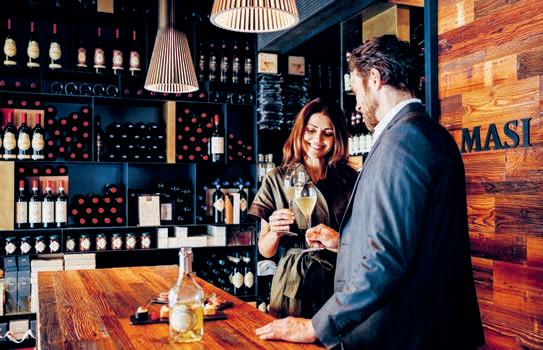
eted communication: lifestyle. Through lifestyle, in fact, Masi has succeeded, unusually for a wine brand, in combining material and abstract values. This mix ture of communications content has enabled Masi to attain the ultimate prize for a business, and in par ticular for a wine business: to be authentic and cred ible. In this field, the great contribution made by San dro Boscaini is of fundamental importance. Before anyone else, he understood the importance of ‘showing all’, of not hiding behind the wines but of being transparent and talking about his own pro duction philosophy, and his own beliefs, while al ways avoiding the clichés. Only in this way could the myth of ‘Mister Amarone’ be born, a moniker that pays tribute to a long career marked by courageous deci sions about production, great entre preneurial ability, and extraordinary communicative vision. Mondadori’s wonderful book Mister Amarone, written by English journalist Kate Singleton, recounts this professional and human journey that began many years ago in a small hamlet in Valpoli cella Classica.
Masi has a wealth of promotional activities and events that it holds an
39
L’occasione dell’anniversario della vendemmia nu mero 250 era troppo ghiotta per lasciarla sfuggi re senza metter nero su bianco una storia che si propone come dimostrazione di quanto il radicamento e l’amore nei confronti della propria terra possa contare nel successo di una dinastia di imprenditori della Valpolicella. A scriverla è Sandro Boscaini, capofila della sesta genera zione di vignaioli e produttori di vino, nonché presidente di Masi Agricola Spa, che ha raccolto il testimone dall’ori ginaria azienda Boscaini per portare il brand Masi ad affer marsi sui mercati di tutto il mondo. Tutto questo è raccon tato in Amarone e oltre. Masi: 250 anni di vendemmie, famiglia e imprendito rialità, con prefazione del prof. Giusep pe Lupo, edito da Egea, l’editrice dell’U niversità Bocconi di Milano. Una scelta non casuale, perché il libro firmato da ‘Mister Amarone’ s’iscrive nel filone delle monografie d’impresa, fondamen tali ‘mattoni’ di una cultura imprendito riale che nel nostro paese ambisce ad un maggior riconoscimento sociale e a mettere radici più profonde. E a sot tolineare il valore ‘universale’ di questa storia il libro verrà proposto anche in lingua inglese dalla Bocconi University Press: Amarone and beyond. Masi: 250 Years of Harvests, Family and Business con prefazione del wine critic Tom Hy land. Il volume si articola in due parti. Nella prima, ‘Note storiche’, Boscaini riunisce le memorie familiari delle gene razioni che l’hanno preceduto nella conduzione dell’azien da e sottolinea i passaggi cruciali che ne hanno costruito l’identità nel tempo, a partire dalla prima vendemmia nel 1772 nel vaio dei Masi, e ne hanno sviluppato la rete di re lazioni commerciali. Un’avvincente cavalcata storica fino all’approdo in Borsa nel 2015, attraverso ‘due secoli di im pegno e coerenza, di sviluppo e reputazione’, com’è titola to un capitolo finale di questa sezione. La seconda parte si proietta invece nel futuro. I tredici capitoli di ‘Attualità: valori e strategia’ rappresentano una mappa strategica e dettagliata delle attività e del posizionamento del Gruppo Masi nel contesto attuale della vitivinicoltura mondiale: dalla ricerca sulla sostenibilità intorno al motto ‘nella na tura a passo d’uomo’, all’innovazione che da tre decenni il Gruppo Tecnico Masi sviluppa nel segno dell’originalità tecnica dell’appaxximento, sino al progetto più recente, Masi Wine Experience, che punta ad istituire un rapporto diretto con il consumatore.
AMARONE AND BEYOND: THE BOSCAINI FAMILY, ITS ROOTS AND ITS FUTURE
The 250th anniversary grape harvest was too good an opportunity to miss writing about how love for the land and recognition of one’s roots in it can be important in the success of a dynasty of en trepreneurs in the Valpolicella region. The book’s author is Sandro Boscaini, head of the sixth generation of a family of vignerons and wine producers, as well as Presi dent of Masi Agricola Spa, the man who picked up the baton from the original Boscaini company to bring the Masi brand to prominence on markets all over the world. Amarone e oltre. Masi: 250 anni di vendemmie, famiglia e imprenditorialità has a preface by Prof. Giuseppe Lupo and comes from Egea, the publisher for Milan’s Bocco ni University. Which is no accident, as the book written by ‘Mister Amarone’ is part of a series of business mono graphs, describing the building blocks of an entrepreneurial culture that cur rently seeks greater social recognition and deeper roots in Italy.
To underline the ‘universal’ value of this story, however, the book will also be available in English as Amarone and beyond. Masi: 250 years of vintages, family and entrepreneurship, pub lished by the Bocconi University Press, with a preface by wine critic Tom Hy land. The book has two parts. In the first section, ‘Historical notes’, Boscaini assembles family memories of the generations that preceded him in the running of the company and describes the most impor tant steps that have shaped its identity over time, start ing with the first harvest in the Vaio dei Masi in 1772 and the development of a network of business relationships. Subsequent adventures lead up to the company’s launch on the stock exchange in 2015, after ‘Two centuries of constant effort, development and reputation’, as the fi nal chapter of this section is called. The second part looks into the future. The thirteen chapters of ‘Our times: values and strategy’ are a stra tegic map of the Masi Group’s activities and positioning in the modern world of international winemaking: from research into sustainability (‘with nature at a human pace’), to the innovations that the Masi Technical Group has been developing for three decades in the unique ap passimento field. Finally, there is the most recent project, the Masi Wine Experience, which aims to establish a di rect relationship with the consumer.

AMARONE E OLTRE: LA FAMIGLIA BOSCAINI TRA
RADICI E FUTURO
egeaonline.it
Masi ha una ricchezza di iniziative e di eventi che promuove annualmente. Un grande esempio di co municazione creativa è il progetto ‘Costasera Con temporary Art’, che coinvolge artisti internazionali nell’ideazione di un’originale etichetta per l’amarone, cui consegue anche una borsa di studio dedicata ai giovani per imparare l’arte vetraria di Murano: cultu ra, arte e produzione vanno a brac cetto. Nell’anno delle celebrazioni delle sue 250 vendemmie tra le mol te iniziative spicca la pubblicazione da parte di Egea, casa editrice della Bocconi, del volume Amarone e ol tre. Masi: 250 anni di vendemmie, famiglia e imprenditorialità scritto da Sandro Boscaini stesso. Parallela mente possiamo godere della mes sa in onda di una serie di podcast dal titolo ‘Buon Tempo! 250 anni di Masi’, realizzata da Matteo Cac cia di Radio24, forse lo storyteller più amato e seguito: otto puntate anche in inglese per gli ascoltato ri internazionali. La costruzione di un dialogo diretto con il consuma tore è sempre stata tra gli obiettivi primari dell’azienda. Oggi avviene sia attraverso i social network, sia attraverso la ‘Masi Wine Experience’, che può forse essere considerata il modello più avanzato di offerta enoturistica in tutte le sue forme, da quelle più tradizionali (l’accoglienza nelle aziende del Gruppo) a quelle più innovative (i Wine Bar sul lago di Garda, a Cortina, a Monaco…). Ed in quest’ultima direzione si inserisce il progetto va rato in occasione delle celebrazioni: ‘Monteleone21’ è un complesso polifunzionale che amplierà l’attuale cantina con nuovi spazi dedicati all’attività produttiva, direzionale ed enoturistica, una nuova perla nella col lana della Masi Wine Experience. Se non sono pionieri quelli della Masi… chi altro?
nually. A prime example of creativity in the commu nications field is the ‘Costasera Contemporary Art’ project, which involves international artists making specially created labels for Costasera Amarone, ac companied by a scholarship for young people to learn the art of Murano glassmaking. This way cul ture, art and wine go hand in hand. As the company celebrates its 250th vintage, one of the many associated promotional activities is the publication by Egea – the Bocconi publishing house –of Amarone and beyond. Masi: 250 years of harvests, family and busi ness written by Sandro Boscaini himself.
Matteo Caccia, Radio24-Il sole24Ore, ha realizzato il podcast
‘Buon Tempo’ - 250anni di Masi’ Matteo Caccia, Radio24-Il sole24Ore, has recorded the podcast ‘Buon Tempo - 250 years of Masi’ masi.it

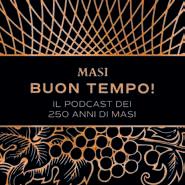
At the same time we can enjoy the airing of a podcast series entitled ‘The Magic of Time! 250 years of Masi’, produced by the popular sto ryteller Matteo Caccia of Radio24 and available in eight episodes, in English too, for international listen ers. Creating a direct dialogue with the consumer has always been one of the company’s primary objec tives. Today, this takes place both through social media networks and through the ‘Masi Wine Experience’, which is perhaps the most advanced model of multifaceted wine tourism on offer, from the more traditional (hospitality in the Group’s wineries) to the more in novative (Wine Bars on Lake Garda, in Cortina, and in Munich…).
And it is in the ‘innovative’ category that this latest project fits: ‘Monteleone21’ is a multifunctional com plex that will complement the current winery with new spaces dedicated to production, management and wine tourism, and become a new jewel in the Masi Wine Experience crown. If these people at Masi are not pioneers… who is?
Fabio Piccoli, giornalista, esperto in economia e marketing del vino, è direttore responsabile del magazine internazionale online ‘Wine Meridian’ e consulente per aziende e istituzioni in Italia e all’estero. È autore e co-autore di diversi libri, tra i più recenti L’enoturismo vincente e Italian Wine Tour 2021 (2021).
Fabio Piccoli, journalist and expert on the economics and marketing of wine. Executive Director of the international online magazine ‘Wine Meridian’. Consultant for companies and institutions in Italy and abroad. Author and co-author of many books, including the recent L’Enoturismo vincente e Italian Wine Tour 2021 (2021).

41
CONTINUITÀ E... MASI
E IL RAPPORTO
IL PASSATO CONTINUITY AND… MASI AND THE RELATIONSHIP WITH THE PAST
CON
di Richard Baudains
Sette decenni di Amarone per assaggiare la storia di un vino iconico Seven decades of Amarone, tasting the history of an iconic wine
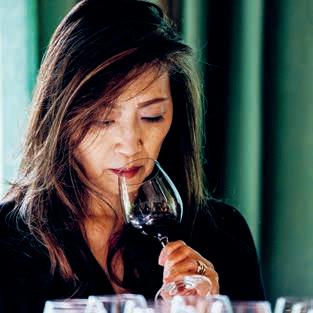
Gli italiani attribuiscono grande importanza al legame con il passato. Le narrazioni iniziano immancabilmente nello specchietto retrovisore. È un modo per risalire all’origine delle cose, per trovare riscontro nella conti nuità, oppure giustificare una rottura con il passato o semplicemente per festeggiare. È per tutti questi mo tivi che il 14 ottobre 2022 ci siamo ritrovati seduti a un lungo tavolo nei luminosi saloni di villa Serego Alighe ri con 28 calici di Amarone versati davanti a noi, per una degustazione densa di significati: la celebrazione di una famiglia di vitivinicoltori, la celebrazione dell’A marone e la celebrazione della qualità senza tempo dei grandi vini. Questo racconto potrebbe avere diversi punti d’inizio. Potrebbe essere l’anno 1772, quando un certo Giobatta Boscaini firmò un contratto per l’af fitto di vigneti nel Vaio di Masi nelle alte colline della Valpolicella che, in seguito, la fami glia Boscaini acquistò grazie ad un matrimonio. Appunto 250 anni fa ebbe inizio la storia ininterrotta di una famiglia di produttori di vino. Ma potrebbe aver avuto origine molto tempo prima, con un altro contratto, quando nel 1194 i mo naci di San Zeno affittarono vigneti
The tasting started with the 1958 vintage, one of the best of the decade
The Italians attach great importance to connecting with the past. Narratives invariably begin in the rear view mirror. It is a way to trace the origins of things, to find validation in continuity, or justification in a break from the past, or simply to celebrate. It was for all these reasons that we found ourselves seated at a long table in the luminous salons of the Serego Aligheri villa on 14th October 2022 with 28 glasses of Amarone poured before us, for a tasting dense with significance, a celebration of a wine making family, a celebration of Amarone, a celebration of the timeless quality of great wines. This narrative could start at many different points. It could be the year 1772, when a certain Giobatta Boscaini signed a contract for the lease of vine yards in the Vaio di Masi in the high hills of the Valpolicella, vineyards which the Boscaini family later acquired by marriage. The story of a fam ily with 250 years of continuous wine production begins here. But the story could begin a very long time before, with another con tract, when in 1194 the monks of San Zeno rented vineyards at the
42 UN VINO UNA STORIA WINE STORIES
Una degustazione partita dall’annata 1958 tra le migliori del decennio
Raffaele Boscaini: “Abbiamo celebrato queste 250 vendemmie con un magnifico assaggio verticale e anche orizzontale delle nostre produzioni di Amarone”

Raffaele Boscaini: “We celebrated 250 vintages with a magnificent vertical and horizontal tasting of our Amarone wines”
Pagina precedente. Kumiko Yamada: “Mazzano… elegantissimo! Vorrei comunicare questo in Giappone. Io adoro Masi!”
Previous page. Kumiko Yamada: “Mazzano… very, very elegant! I would like to tell them about this in Japan. I adore Masi!”




























SETTE DECENNI DI AMARONE MASI SEVEN DECADES OF MASI AMARONE 1. AMARONE CLASSICO 1958 3. AMARONE CLASSICO 1974 2. CAMPOLONGO DI TORBE 1979 3. MAZZANO 1979 5. AMARONE CLASSICO 1988 4. VAIO ARMARON 1986 5. CAMPOLONGO DI TORBE 1986 7. AMARONE CLASSICO COSTASERA 1997 6. MAZZANO 1986 7. VAIO ARMARON 1997 9. AMARONE CLASSICO COSTASERA 2009 8. CAMPOLONGO DI TORBE 1997 9. MAZZANO 1997 11. AMARONE CLASSICO COSTASERA 2016 10. VAIO ARMARON 2007 11. CAMPOLONGO DI TORBE 2007 13. RISERVA AMARONE CLASSICO COSTASERA 2015 12. MAZZANO 2007 13. VAIO ARMARON 2012 14. CAMPOLONGO DI TORBE 2012 15. MAZZANO 2012 L’AMARONE E IL TERROIR: I CRU AMARONE AND TERROIR: CRUS L’EVOLUZIONE DELL’AMARONE THE EVOLUTION OF AMARONE 1. VAIO ARMARON 1979 2. AMARONE CLASSICO 1962 4. AMARONE CLASSICO 1980 6. AMARONE CLASSICO 1990 8. AMARONE CLASSICO COSTASERA 2003 10. AMARONE CLASSICO COSTASERA 2012 12. RISERVA AMARONE CLASSICO COSTASERA 2003
Dal 1958 al 2015: una “degustazione storica di amaroni fantastici”, come l’ha definita Jens Priewe From 1958 to 2015: an ‘historic tasting of fantastic Amarones', was what Jens Priewe called it
nelle colline della valle del Negrar, nell’area che corri sponde oggi ai vigneti cru dei Boscaini a Torbe e Maz zano. Non c’è maggiore garanzia della vocazione di un terroir che ha una storia di coltivazione di oltre 800 anni. Generazioni di proprietari vanno e vengono, ma la cura costante della terra è “il punto fermo nel mon do che cambia”. Poi ci sono l’elemento umano e le tradizioni enologiche tramandate nei secoli. O ancor più, il primo inizio potrebbe risalire fino alla scoperta del delicato processo di ‘appassimento’ delle uve della Valpolicella ai tempi dell’Impero Romano. Ovunque si guardi nel presente, c’è sempre un elemento del pas sato, dipende solo dove si vuole avviare la narrazione. Il racconto della nostra degustazione di Amaroni parte dal 1958, con un vino prodotto da Guido Boscaini figlio di Paolo Boscaini, fondatore nel 1882 dell’azienda Pao lo Boscaini & Figli e padre del presidente Masi Sandro. Forse Sandro aiutò a raccogliere queste uve durante le vacanze universitarie, come fan no tutti i membri di una famiglia di viticoltori. L’annata 1958 è stata valutata una delle migliori del de cennio e i suoi aromi continuano ad invogliare, con accattivanti note di spezie dolci ed erbe aromatiche. L’amarone 1962 è delicatamente profumato di violette e frutti di bo
Gli anni Ottanta: il decennio della ricerca che reinventò l’Amarone
The Eighties is the decade of research which reinvented Amarone
top of the valley of Negrar in the area which cor responds today to Boscaini’s cru sites at Torbe and Mazzano. There is no greater validation of a terroir than a history of over 800 years of land use. Gener ations of owners come and go, but when the land is cared for it is “the still point in the changing world”. Then there is the human element, the winemaking traditions handed down through the centuries. The first chapter in this story could trace the discovery of the delicate process of the ‘appassimento’ of the grapes of the Valpolicella, to the early Roman Em pire. Wherever you look in the present, there is al ways an element of the past. It just depends where you want to start the narrative. The story of our tasting begins in 1958, with a wine made by Guido Boscaini, son of Paolo Boscaini, founder in 1882 of the firm Paolo Boscaini & Figli and father of Masi President Sandro. Perhaps San dro helped to pick these grapes during his university holidays, as all the members of the family do in a family firm. 1958 was consid ered one of the best vintages of the decade and its aromas con tinue to entice, with their notes of sweet spice and herbs. The 1962 is subtly perfumed with violets and
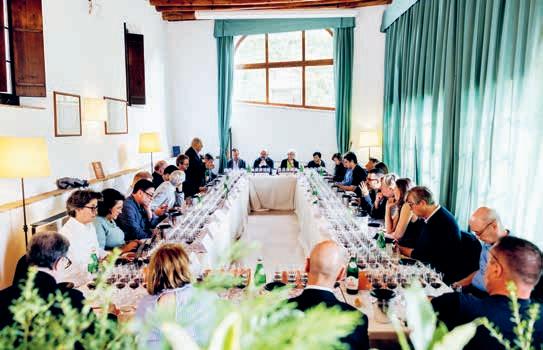
45
sco e il meraviglioso ed elegante 1974, nonostante l’e tà, è uno dei vini più moderni dell’intera degustazione. Queste tre annate appartengono all’epoca della vinifi cazione più tradizionale, caratterizzata da un appassi mento delle uve protratto fino a febbraio. Verso la fine degli anni ’70 Sandro Boscaini iniziò a riflettere sulla necessità di rompere gli schemi tradizionali e realizzare un Amarone più contemporaneo. Saltando al 1988 rag giungiamo quello che è considerato il culmine di più di un decennio di ricerca per ‘reinventare’ l’Amarone, così come dice Sandro. Il colore è profondo, il naso preci so e plumbeo, i tannini rotondi e morbidi. Gli anni ’90 hanno visto due grandi annate: la 1990 splendidamente raffinata al naso e al palato e la 1997 potente e dinami ca. Il 2003 raccolto in anticipo è caratterizzato più dalla sua architettura robusta che dai suoi aromi e questo sottolinea le sfide del numero crescente di estati calde.
Poi c’è una serie di annate spettacolari: 2009 (fruttato brillante), 2012 (prugna e cioc colato fondente), 2015 Riserva (profondo e lungo), 2016 (frut ti di bosco), tutte e quattro di stile contemporaneo, si trova no nella prima esuberante fase fruttata della loro evoluzione, ma ognuna con la propria per sonalità. Se il Costasera Ama
Per le grandi selezioni di cru Masi il perfetto equilibrio alcolico è intorno ai tradizionali 16°
For Masi’s great cru wines, the perfect alcohol balance is around the traditional 16°
berries and the wonderfully elegant 1974, despite its age, is one of the most modern wines in the whole tasting. These three vintages belong to the age of more traditional winemaking, characterized by grape drying that stretched well into February. Towards the end of the ’70s Sandro Boscaini began to reflect on the need to break the traditional mould and make a more contemporary Amarone. Jump forward to 1988 and we have what could be seen as the culmination of over a decade of research to, in Sandro’s words ‘reinvent’ Amarone. The colour is deep, the nose pre cise and plummy, the tannins round and soft. The 1990s saw two great vintages, the 1990 beautifully refined on the nose and palate, the 1997 powerful and dynamic. The early-picked 2003 appeals for its robust architecture more than its aromas, and this underlines the challenges of the increasing number of hot summers. Then there is a string of spectacular vintages: 2009 (bright fruit), 2012 (plum and dark choco late), 2015 Riserva (deep and long) 2016 (wild berries), all four contemporary in style, all in the first exuberant, fruit driven phase of their evolu tion, but each with their own personality.

46
rone Classico si presenta oggi con una gradazione al colica più moderata, le grandi selezioni di cru trovano il loro perfetto equilibrio intorno al tradizionale 16%.
Vaio Armaron Serego Aligheri di solito offre un im patto immediatamente espressivo al naso, con il ca ratteristico intenso fruttato di uva appassita e spesso con sfumature di botrite di tartufo. L’annata 1986 mo stra l’ampiezza e la complessità dei suoi aromi (iris e buccia di mandarino si insinuano nel bouquet).
Campolongo di Torbe Amarone è voluttuosamente corposo donando aromi di ciliegia e mandorla tipici della Valpolicella, ma il 1979 (mozzafiato!) dimostra anche la sua capacità di evolvere in soave raffinatezza. Mazzano Amarone, il più rigoroso del trio, asciutto, elegante e sottilmente austero, è capace di un invec chiamento prodigioso; infatti il recente 2012 ha già un senso di autorità magistrale. Allora, qual è l’annata da portare a casa per ciascuno dei tre cru? Il 1997, che unisce potenza e personalità del terroir, perfetto da gustare ora per chi ha la fortuna di averne riposto in cantina un’ulteriore bottiglia.
Richard Baudains, giornalista esperto di vino, contribuisce alla rivista Decanter dal 1989 con particolare riguardo al vino italiano. È membro della giuria regionale del prestigiosi Decanter World Wine Awards, cura la guida Slow Wine del Friiuli Venezia Giulia. È docente all’Università di Scienze Gastronomiche e alla Cambridge University.

I giornalisti, masters of wine e wine critics mondiali che hanno partecipato alla straordinaria verticale di 28 grandi annate
The journalists, masters of wine, and international wine critics took part in an extraordinary vertical tasting of 28 great vintages
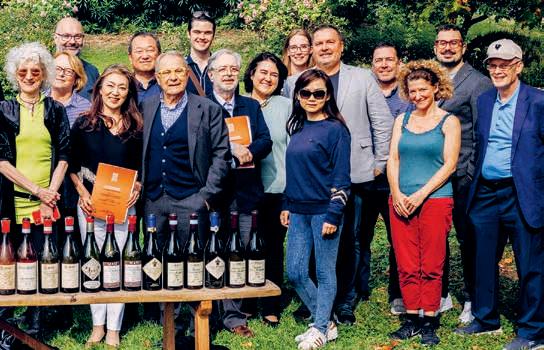
If the Costasera Classico comes nowadays with more user-friendly alcohol levels, the great Cru selections defiantly find perfect balance at around the tradition al 16%.
Serego Aligheri Vaio Armaron is generally the most immediately expressive on the nose, with a distinctive raisined grape character and often botrytis notes of truffle. The 1986 vintage shows the breadth and com plexity of its aromas (iris and tangerine peel creep into the bouquet). Campolongo di Torbe is voluptu ously full-bodied with the classic cherry and almond character of Valpolicella, but the breath-taking 1979 also demonstrates its capacity to evolve into suave refinement. Mazzano, the most rigorous of the trio, bone dry, elegant and subtly austere, is capable of prodigious ageing, but the 2012 already has a sense of magisterial authority.
The take home vintage for all three? The 1997, which combines power with terroir definition, drinking per fectly now for those with the good fortune to have put away a bottle.
47
Richard Baudains, journalist and wine expert, contributor on Italian wine for Decanter magazine since 1989. Regional jury member for the prestigious Decanter World Wine Awards, curates the Slow Wine guide for Friuli Venezia-Giulia. Lecturer at the University of Gastronomic Sciences and at Cambridge University.
A PASSEGGIO PER CORTINA CON

GLI SCRITTORI CHE L’AMARONO
WALKING IN CORTINA WITH THE
WRITERS WHO LOVED IT
di Sergio Frigo
Nel capoluogo ampezzano un parco letterario ‘diffuso’ ispirato da Goffredo Parise
A ‘widely spread out’ literary park inspired by Goffredo Parise in the Ampezzo capital

Sono pochi i luoghi al mondo che possono vanta re tanti ‘testimonial’ illustri come Cortina. Da oltre un secolo il capoluogo dell’Ampezzano è meta di scritto ri, intellettuali, registi, attori di tutto il mondo, che ne hanno raccontato i boschi, i prati, le crode, le piste da sci, gli alberghi in altrettante narrazioni, letterarie e ci nematografiche. Ci sono tra loro alcuni fra i nomi più importanti della letteratura del Novecento, da Ernest Hemingway a Edward Morgan Forster, da Saul Bellow a Vladi mir Nabokov, agli italiani Mora via, Montale, Piovene, Buzzati, Zanzotto, Parise. Per riscoprire e valorizzare queste reminiscenze letterarie la rassegna ‘Una Montagna di libri’ promuo verà il prossimo anno il progetto ‘Accadde a Cortina’, che mutua il titolo da un celebre articolo proprio di Goffredo Parise, pubblicato sul ‘Corriere’ il 14 gennaio 1980: si tratta, in buona sostanza, di un parco letterario che però sviluppa e perfeziona iniziative analoghe già realizzate sui luoghi di Antonio Fogazzaro, sull’Altopia no di Asiago per Mario Rigoni Stern, sui Colli Euganei (per restare nel Veneto), ma anche nel Carso col Par co Ungaretti, o nelle Langhe, per Fenoglio e Pavese. “In città e nelle montagne attorno – spiega il responsabile
There are few places in the world that have been eu logised by so many famous creative artists as Corti na. For more than a century, the capital city of the Ampezzo region has been the haunt of authors, intel lectuals, film directors and actors from all over the world who have depicted its woods, meadows, cliffs, ski slopes and hotels in numerous literary and cin ematographic works. Among them are some of the most important names in 20th century literature, from Ernest Hemingway to E. M. Forster, from Saul Bellow to Vladimir Nabokov, plus the Italians: Moravia, Mon tale, Piovene, Buzzati, Zanzotto and Parise. Next year, to highlight and promote the literary works involved, the Montagna di Libri Festival is holding an event called ‘Accadde a Cortina’, or ‘It happened in Cortina’. The title comes from a famous article written by Gof fredo Parise, published in the Corriere newspaper on 14 January 1980. The event is, in essence, a ‘literary park’ that takes its inspiration from similar initiatives held in the past, including one for the places associat ed with Antonio Fogazzaro, one on the Asiago Plateau for Mario Rigoni Stern, and one in the Euganean Hills
48 SERVIZI FEATURES
di ‘Una Montagna di libri’ Francesco Chia mulera – il prossimo anno saranno dislo cati una ventina di cartelli in acciaio che riporteranno alcuni testi degli scrittori e la loro contestualizzazione (quando è stato a Cortina e per fare cosa), oltre a un Qr code che rimanderà a una piattaforma in cui ci saranno testi più approfonditi e anche una regi strazione audio (ad opera di qualche attore), per ren dere questi contenuti accessibili anche ai non vedenti, oppure a coloro che decidono di ascoltare proseguen do la passeggiata”. Per i fruitori più tradizionali i testi saranno anche raccolti in una piccola guida cartacea. L’operazione – essendo realizzata principalmente in di gitale – richiederà un investimento piuttosto limitato, sostenuto dagli enti locali ma anche da sponsor privati e con un crowfunding che sarà lanciato a breve da ‘Una Montagna di libri’ col motto ‘Cortina è tua’. Un’inizia tiva, questa, che ne rafforza l’immagine anche in pro spettiva dei Giochi Olimpici invernali del 2026. Stante la gran mole di riferimenti letterari disponibi li resterà fuori giocoforza qualche autore (ad esem pio i viventi, oppure chi a Cortina c’è stato ma senza scrivervi nulla di significativo) ma alcuni nomi saran no imprescindibili, a partire da Goffredo Parise che nell’articolo citato racconta della sua grande passione
– just to talk of the Veneto. Others include the one at the Parco Ungaretti in the Carso, or in the Langhe for Fenoglio and Pavese. “Next year there will be around twenty steel billboards erected in the city and in the mountains nearby,” explains the ‘Montagna di Libri’ Festival director, Franc esco Chiamulera. “They will reproduce extracts from writing about Cortina and explain the context. Viewers will be able to scan a QR code which will take them to in-depth explanations and to actor-voiced recordings to make content accessible to the blind, or to those who decide to listen as they continue their trip.” For visitors used to more traditional media, the ex tracts will also be available as a paper booklet. The operation, being mainly digital, will require minimal funding and will be supported by the local authori ties. Private sponsors will also be involved, together with a crowdfunding exercise called ‘Cortina is yours’ to be launched soon by Montagna di Libri, now even more important for Cortina’s reputation given the ap proach of the 2026 Winter Olympics. Given the number of literary references available, some authors will inevitably be left out (those alive today, for example, or those who never wrote any thing particularly striking), but some names are ob
I nuovi percorsi letterari, segnalati da una cartellonistica multimediale, si snoderanno tra Cortina e le Dolomiti circostanti. Qui il Col Drusciè, con il Masi Wine Bar. Pagina precedente. Il Lago di Limides

The new literary pathways, with multimedia signposting, wind through Cortina and the surrounding Dolomities. Here we are at Col Drusciè, by the Masi Wine Bar. Previous page. Lake Limedes

per lo sci, che proprio all’ombra delle Tofane trovò il suo massimo coronamento, tanto da fargli scrivere in chiusura, a commento di una discesa solitaria tra la neve fresca e immacolata, “Si, sono e sono stato vera mente felice di vivere”. E forse oggi lo scrittore che fu tra i primi cantori dell’A marone, avrebbe una ragione in più per ribadirlo, so stando tra una discesa e l’altra al Col Druscié dove nel frattempo è stato allestito un Masi Wine Bar. Un altro protagonista non potrà che essere quell’Ernest He mingway (che un giovanissimo Parise andava a spia re mentre pescava nel Boite) che stazionava al bar dell’Hotel Posta scolando Blo ody Mary e proprio a Cortina sperimentò col breve racconto Fuori stagione (del 1923) nuo ve tecniche narrative e iniziò a scrivere (nel ’48) Di là dal fiume e tra gli alberi ispirato alla sua nuova, tormentata storia d’a more con Adriana Ivancich. Altrettanto importante, dal punto di vista letterario ma anche per il tema che affron ta, è uno dei primi racconti di Edward Morgan Foster (autore di Camera con vista, Casa Ho
ligatory, starting with Goffredo Parise. He wrote of his great passion for skiing, above all in the shadow of the Tofane, which inspired him to conclude after one particular solitary descent in pristine snow: “Yes, I am alive and I have been truly happy to be alive”. And perhaps today this same author, who was also one of the first to eulogise Amarone as a wine, would have been even happier to celebrate his de scent as he could have taken a break at Col Druscié where a Masi Wine Bar has now been opened. An other ‘must have’ for the collection is Ernest Hem ingway (as spied on by a very young Parise when fishing in the Boite river) who used to hang out at the bar in Hotel Posta, sipping Bloody Marys. It was in Cortina that he tried out new narrative techniques in his short story Out of Season (1923) and be gan writing Across the River and into the Trees (in 1948) while inspired by the tor ments of his new love for Adriana Ivancich. Just as im portant from a literary point of view, but also for its theme, is one of the first short sto

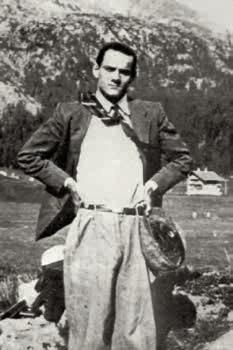
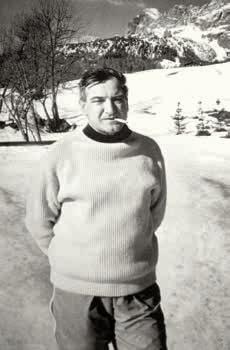

50
Saul Bellow
ward e Passaggio in India), L’attimo eterno, concepito e ambientato nel 1902 in una Cortina che stava cono scendo il turismo di massa. Fra gli altri autori stranieri non mancheranno, naturalmente, la scopritrice delle Dolomiti Amelia Edwards e l’autore di Lolita Vladimir Nabokov, che veniva quassù a catturare farfalle, di cui era un appassionato studioso, e fra gli italiani Alber to Moravia, che fu ricoverato giovanissimo per una tubercolosi ossea nel sanatorio Codivilla, lasciandoci pagine molto significative sulla sua esperienza in In verno di un malato. Ad aggiungere fascino letterario a luoghi e paesaggi già di per sé straordinari ci saranno anche le pagine di Buzzati, Comisso, Piovene, Mon tanelli, Arbasino, Zanzotto e gli indimenticabili versi di Eugenio Montale dedicati al Sorapis: “Fu quello il nostro lago, poche spanne d’acqua, / due vite trop po giovani per essere vecchie, / e troppo vecchie per sentirsi giovani”. Perché Cortina non è solo Cortina, ma sono anche le innumerevoli perle che le fanno co rona e che suscitano da sempre incanto e poesia in chiunque le incontri.
Sergio Frigo, giornalista, autore de veneti, presiede il Premio Rigoni Stern. Al suo attivo numerose collaborazioni e curatele editoriali. Tra i suoi libri: Il Nordest tra emigrazione e immigrazione essere leghista ma proprio non ci riesco Furegon per il giornalismo sociale e Lago per la cultura.

Pagina precedente Preceding page. Goffredo Parise, Ernest Hemingway e Adriana Ivancich, Alberto Moravia
A lato. Meraviglioso scorcio sulle Dolomiti Ampezzane viste dal Masi Wine Bar
This page. Wonderful view of the Ampezzo Dolomites seen from the Masi Wine Bar

ries by E. M. Foster (author of Room with a View, Howard’s End and Passage to India): The Eternal Moment was written and set in Cortina in 1902 at a time when it was experiencing mass tourism. Other foreign authors include, of course, the discoverer of the Dolomites, Amelia Edwards, and the author of Lolita, Vladimir Nabokov, who used to visit in search of a real passion, butterflies. The Italian contingent includes Alberto Moravia, who was treated for bone tuberculosis in the Codivilla sanatorium at a very young age, leaving us with a moving reminder of his experience in Winter of a Sick Man Adding literary charm to beautiful places, there will also be extracts from Buzzati, Comisso, Piovene, Mon tanelli, Arbasino, Zanzotto, and Eugenio Montale’s un forgettable verses dedicated to Lake Sorapis: “That was our lake, a few lengths of water, / two lives too young to be old, / and too old to feel young”. Because Cortina is not only Cortina, but also the countless pearls in its crown: the source of enchantment and poetry for anyone who encounters them.
Sergio Frigo, journalist, author of I Luoghi degli Scrittori veneti, chairs the Premio Rigoni Stern. Co-author of a guide to Venice, co-editor of the book series I grandi scrittori del Nordest, author of Noi e loro, Il Nordest tra emigrazione e immigrazione and Caro Zaia, vorrei essere leghista ma proprio non ci riesco. Winner of Premio Furegon for journalism and Premio Lago for culture.
51
Nella motivazione per l’attribuzione del Premio Civiltà Veneta 2018, Carlo Nordio fu definito “luminosa figu ra di servitore della giustizia, mai disgiunta da umanità e garanzia dei diritti costituzionali”. Dal 22 ottobre l’ex magistrato e oggi senatore di Fra telli d’Italia, è ministro della Giustizia nel governo Meloni. Classe 1947, liberale di formazione e cultura, Nor dio ha lasciato la magistratura nel 2017 dopo quattro decenni di servizio. In prima fila nella lotta al terrori smo e ai sequestri di persona tra gli anni Settanta e Ottanta, e poi alla corruzione (sua l’inchiesta sul com plesso giro di malaffare intorno alle barriere del Mose di Venezia), si è sempre battuto “per un’Italia più equa e per una ‘cosa pubblica’ più trasparente”.
Tra il 2006 e il 2008 è stato presidente della Commis sione per la riforma del Codice penale ed ha appena pubblicato per i tipi di Guerini Giustizia ultimo atto. Da tangentopoli al crollo della magistratura. Di una cosa si è sempre detto convinto: “l’inasprimen to delle leggi non serve a sconfiggere la corruzione; serve invece togliere le armi a chi si fa corrompere, armi che purtroppo sono le stesse leggi: troppe e contraddittorie”.
Grande appassionato di letteratura e scrittore, a suo dire “un magistrato deve avere due virtù: umiltà e buon senso, che si imparano solo attraverso la cono scenza dei nostri limiti e difetti. La cultura generale e soprattutto i grandi classici ti ridimensionano sempre quando assumi posizioni di potere”.
UN PREMIO CIVILTÀ VENETA COME
MINISTRO
DELLA GIUSTIZIA CIVILTÀ VENETA PRIZE AS MINISTER OF JUSTICE

In the citation for the Civiltà Veneta Prize 2018, Carlo Nordio was described as a “shining example of a serv ant of justice, never detached from humanity and a champion of constitutional rights”. On 22 October, the former magistrate and now Fratelli d’Italia senator was made Minister of Justice in the Meloni government. Born in 1947, a liberal by nature and education, Nordio left the judiciary in 2017 after four decades of service. At the forefront in the fight against terrorism and kidnappings between the 1970s and 1980s, and then against corruption (he headed investigations into the complex corruption ring around the Mose barri ers in Venice), he has always fought “for a fairer Italy and more transparency towards the public”. Between 2006 and 2008 he was chairman of the Commission for the Reform of the Penal Code and has just pub lished Giustizia ultimo atto. Da tangentopoli al crollo della magistratura (Guerini). He has always been con vinced of one thing: “Tightening up the laws is not what defeats corruption; instead we need to remove the weapons from those who take bribes, the weap ons that are unfortunately the laws themselves: they are too many and too contradictory.”
A great lover of literature and an author himself, he declares “a magistrate must have two virtues: humility and common sense, which can only be learnt through knowledge of our limits and defects. The prevailing culture and, above all, the great classics always rede fine you when you assume positions of power.”
52
DALLA FONDAZIONE MASI APPROFONDIMENTI FROM THE MASI FOUNDATION INSIGHTS
Marzio Breda e Carlo Nordio (2018)
ORHON PREMIATO DALL’OIV PER IL SUO LES FRUITS DE L’EXIL
Jacques Orhon, presidente dell’Associazione Sommelier del Canada e Premio Civiltà del Vino 2011, ha ricevuto in settembre a Bordeaux il Premio letterario dell’Organizzazione internazionale della Vigna e del Vino-Oiv, per il romanzo Les fruits de l’exil pubblicato nel 2021 da Éditions de l’Homme.
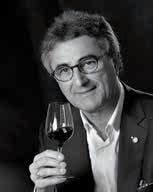
OIV HONOURS ORHON FOR HIS LES FRUITS DE L’EXIL
Jacques Orhon, President of the Canadian Association of Professional Sommeliers and winner of the Civiltà del Vino Prize 2011, was given the International Organisation of Vine and Wine-OIV Literary Award in Bordeaux in September for his novel Les fruits de l’exil (The fruits of exile), published by Éditions de l’Homme in 2021.
AD ANTONIA ARSLAN IL PREMIO COMISSO ALLA CARRIERA
L’8 ottobre la scrittrice Antonia Arslan, premio Civiltà Veneta 2007, ha ricevuto nel Teatro Comunale di Treviso il Premio Giovanni Comisso alla Carriera, promosso dall’omonima associazione Amici dello scrittore trevigiano, scomparso nel 1969, e da CentroMarca Banca.
ANTONIA ARSLAN GIVEN THE COMISSO LIFETIME ACHIEVEMENT AWARD
On 8 October, the writer Antonia Arslan, winner of the Civiltà Veneta Prize 2007, was given the Giovanni Comisso Lifetime Achievement Award at Treviso’s Municipal Theatre. The award was sponsored by the Friends of Giovanni Comisso (who died in 1969) and by CentroMarca Banca.

‘LA REALTÀ DEL SOGNO’: GUARIENTI IN MOSTRA A FERRARA
Il Castello estense di Ferrara ospita fino al 22 gennaio 2023 la mostra ‘Carlo Guarienti, la realtà del sogno’. Ideata da Vittorio Sgarbi, è un omaggio ai 99 anni dell’artista trevigiano, premio Civiltà Veneta 1998, protagonista da oltre mezzo secolo del panorama artistico nazionale ed europeo.
‘THE REALITY OF THE DREAM’: GUARIENTI ON SHOW IN FERRARA
The Este Castle in Ferrara is hosting the exhibition ‘Carlo Guarienti, the reality of the dream’ until 22 January 2023. Curated by Vittorio Sgarbi, the exhibition celebrates the 99th birthday of the artist from Treviso, winner of the Civiltà Veneta Prize 1998 and a leading player on the national and European art scene for over half a century.
IL CARDINALE ZENARI PRESENTA I RISULTATI DI ‘OSPEDALI APERTI’
Il cardinal Mario Zenari, Nunzio vaticano in Siria e Grosso d’Oro veneziano 2018, ha presentato a Roma i risultati del progetto ‘Ospedali Aperti in Siria’ che, attraverso tre ospedali e quattro dispensari sostenuti dalla solidarietà internazionale, eroga 80mila prestazioni sanitarie nel Paese in guerra.
CARDINAL ZENARI PRESENTS THE RESULTS OF ‘OPEN HOSPITALS’
Cardinal Mario Zenari, Vatican Nunzio in Syria and winner of the Grosso d’Oro Veneziano 2018, has unveiled the results of the ‘Open Hospitals in Syria’ project in Rome. Three hospitals and four dispensaries, with international funding, have provided 80,000 healthcare treatments in this war-torn country.

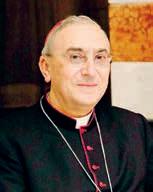
53
FLASH DALLA FONDAZIONE MASI FROM THE MASI FOUNDATION FLASH
ALTAN, LA PIMPA E I SUOI AMICI IN MOSTRA A PORDENONE
Pordenone ha voluto celebrare le 80 primavere di Francesco Tullio-Altan, uno dei più famosi cartoonist italiani, dedicandogli una grande mostra: ‘Altan, la Pimpa e i suoi amici’, in cui viene rivisitato il microcosmo della cagnolina a pois che, dal 1975 ad oggi, hanno ammaliato tante generazioni di bambini.
ALTAN, PIMPA AND HIS FRIENDS ON SHOW IN PORDENONE
Pordenone has decided to celebrate the 80th birthday of Francesco Tullio-Altan, one of Italy’s most famous cartoonists, with a major exhibition of his work. ‘Altan, la Pimpa e i suoi amici’ (Altan, Pimpa and his Friends) revisits the microcosm of the polka-spotted dog that has bewitched so many generations of children since 1975.
BALASSO A TEATRO CON IL SUO ‘DIZIONARIO A COLPI DI TAG’

Natalino Balasso, Premio Civiltà Veneta 2016, sta portando in tournée ‘Dizionario Balasso (colpi di tag)’, lo spettacolo preparato durante lo stop della pandemia e basato sull’improvvisazione con cui l’attore rodigino sul palcoscenico commenta col pubblico parole pescate nel suo “dizionario”.

BALASSO ON STAGE WITH HIS ‘DICTIONARY OF TAG SHOTS’
Natalino Balasso from Rovigo, winner of the Civiltà Veneta Prize 2016, is currently touring ‘Dizionario Balasso (colpi di tag)’, a show created during the pauses in performance during the pandemic and based on the actor’s improvisations on words taken from his ‘dictionary’ by the audience.
MESSNER, UN FILM SULLA TRAGEDIA DEL MANASLU DEL 1972
Anteprima mondiale a Innsbruck di Tempesta sul Manaslu, l’ultimo film di Reinhold Messner, Premio Civiltà Veneta 2021. Il documentario è nato dall’incontro dell’alpinista con gli amici superstiti della tragica spedizione del 1972 sulla vetta himalayana in cui persero la vita Andi Schlick e Franz Jäger.
MESSNER, A FILM ABOUT THE MANASLU TRAGEDY IN 1972

The world premiere of the latest film from Reinhold Messner (Civiltà Veneto Prize 2021) Tempest on Manaslu has been held in Innsbruck. It’s in the form of a documentary about Messner’s meeting with friends who survived the tragic expedition to the Himalayan peaks in 1972 when Andi Schlick and Franz Jäger lost their lives.
IN UN LIBRO LE RIFLESSIONI POST PANDEMIA DI SUSANNA TAMARO
Una riflessione profonda sulla natura e sul nostro posto nel mondo, con i dubbi non solo sulla gestione della pandemia ma sulle intenzioni future della scienza e della politica, è quella che la scrittrice Susanna Tamaro, Premio Civiltà Veneta 2002, propone in Tornare umani (Solferino).
SUSANNA TAMARO’S POST-PANDEMIC REFLECTIONS PUBLISHED
In-depth reflections on nature and our place in the world, with criticism not only of the management of the pandemic but also of developments in the fields of science and politics – this is what writer Susanna Tamaro, winner of the Civiltà Veneta Prize 2002, puts forward in Tornare umani (Solferino).
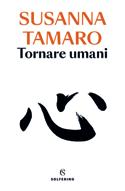
54
FLASH DALLA FONDAZIONE MASI FROM THE MASI FOUNDATION FLASH
LIBRO-INTERVISTA DI LORENZETTO AL SINDACO DI VENEZIA
Dopo una brillante carriera da imprenditore, Luigi Brugnaro ha affrontato una sfida più ardua: guidare Venezia, di cui è sindaco dal 2015. Un’esperienza che, incalzato dalle domande di Stefano Lorenzetto, giurato del Premio Masi, ha raccontato nel libro Ci giudicheranno i bambini, edito da Marsilio.
LORENZETTO’S BOOK-INTERVIEW WITH THE MAYOR OF VENICE
After a successful career as a businessman, Luigi Brugnaro faces the tougher challenge of being Venice’s leader, where he has been mayor since 2015. Interviewed by Masi Prize juror Stefano Lorenzetto, Brugnaro’s story is told in the book Ci giudicheranno i bambini (The children will judge us), published by Marsilio.
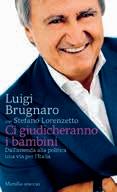
UN LIBRO E UN PREMIO SPECIALE PER CLAUDIO MAGRIS
Lo scrittore triestino Claudio Magris, Premio Civiltà Veneta 1990, ha pubblicato per Garzanti Traduzioni teatrali, che riunisce in un unico volume le versioni per il teatro del grande germanista, insignito lo scorso 15 ottobre ad Alba del Premio Speciale Lattes Grinzane alla carriera.
A BOOK AND A SPECIAL PRIZE FOR CLAUDIO MAGRIS
Trieste-born writer Claudio Magris, winner of the Civiltà Veneta Prize 1990, has published Traduzioni teatrali (Theatrical translations), which brings together in one volume the theatrical works of the great Germanist, awarded the Lattes Grinzane Special Prize for Lifetime Achievement last 15 October in Alba.
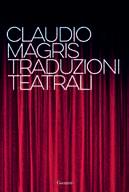
UNA PANAMERICANA CON DUE GRANDI MAESTRI DEL FUMETTO
Due maestri del fumetto come iI compianto Hugo Pratt e Milo Manara, rispettivamente premi Civiltà Veneta nel 1990 e nel 2007, si sono ritrovati nel volume Panamericana (Rizzoli), nel quale l’etica ironica e spietata del maestro veneziano incrocia l’estetica morbida e sensuale di Manara.
TWO GREAT MASTERS OF COMICS IN ‘PAN-AMERICANA’
Two masters of the comic book fomat – the late Hugo Pratt and Milo Manara, respectively awarded the Civiltà Veneta Prize in 1990 and 2007 – are reunited in the book Panamericana (Rizzoli), where the comedic and ruthless ethics of the Venetian master meet Manara’s soft and sensual aesthetics.

FEDERICO FAGGIN IN LIBRERIA CON IL SAGGIO IRRIDUCIBILE
Federico Faggin, premio Civiltà Veneta 1997, è in libreria con Irriducibile. La coscienza, la vita. i computer e la nostra natura. Nel saggio Mondadori, l’inventore dei microchips sostiene che nell’essere umano vi è qualcosa di irriducibile per cui nessuna macchina potrà mai sostituirci completamente.
FEDERICO FAGGIN IN BOOKSHOPS WITH ‘IRREDUCIBLE’
Federico Faggin, winner of the Civiltà Veneta Prize 1997, has a new book out: Irriducibile. La coscienza, la vita. i computer e la nostra natura (Irreducible. Consciousness, life. Computers and our nature) – pub. Mondadori. The inventor of microchips argues that there is something irreducible in the human being, meaning no machine will ever be able to completely replace us.
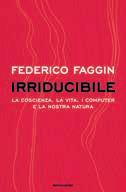
55
FLASH DALLA FONDAZIONE MASI FROM THE MASI FOUNDATION FLASH
BOARD
Presidente / President
Isabella Bossi Fedrigotti
Vicepresidente / Vice-President Sandro Boscaini
Segretario / Secretary Marco Vigevani
Consiglieri / Board Members
Michele Bauli
Francesco Benedetti
Bruno Boscaini
Marzio Breda
Franca Coin
Pieralvise di Serego Alighieri
Federico Girotto Maurizio Marino
Revisore / Auditor Giovanni Aspes
COMMISSIONE DEL ‘PREMIO MASI PER LA CIVILTÀ VENETA’
’MASI CIVILTÀ VENETA PRIZÈ COMMISSION
Sandro Boscaini
Isabella Bossi Fedrigotti
Marzio Breda
Franca Coin
Gabriele Colleoni
Ilvo Diamanti
Pieralvise di Serego Alighieri
Massimo Ferro
Francesco Giavazzi
Stefano Lorenzetto
Piergaetano Marchetti
Paola Marini
Pilade Riello Paolo Possamai
Giovanni Maria Vian Marco Vigevani
Stefano Zecchi Filiberto Zovico
COMMISSIONE DEL ‘PREMIO INTERNAZIONALE MASI PER LA CIVILTÀ DEL VINO’
’INTERNATIONAL MASI CIVILTÀ DEL VINO PRIZÈ COMMISSION
Relatore / Speaker
Federico Castellucci
Piero Antinori
Sandro Boscaini
Luciano Ferraro
Angelo Gaja Jens Priewe Ezio Rivella Alessandro Torcoli dati al 23.11.2022 PER
www.fondazionemasi.com
ALBO D’ONORE DEL PREMIO MASI MASI PRIZE ROLL OF HONOUR
CIVILTÀ VENETA
1981 Elio Bartolini Biagio Marin Giulio Nascimbeni Alvise Zorzi 1982 I Solisti veneti Uto Ughi 1983 Casa Marzotto Bruno Visentini 1984 Antonio Cibotto Gianfranco De Bosio Anna Proclemer 1986 Casa Benetton Ottavio Missoni
Luciano Vistosi 1988 Gaetano Cozzi Giancarlo Ligabue Pilade Riello Fulvio Tomizza
1990 Claudio Magris Zoran Musić
Hugo Pratt 1992 Fernando Bandini Giuseppe Gozzetti Demetrio Volcić 1994 Pier Giuseppe Cevese Renato Olivieri Ermanno Olmi Apollinare Veronesi 1995 Isabella Bossi Fedrigotti Cecilia Danieli Paul Girolami Lucia Valentini Terrani Giuseppe Zigaina
1996 Ivano Beggio Don Antonio Mazzi Pierre Rosenberg
1997 Enzo Bettiza Pierre Cardin
Federico Faggin
1998 Carlo Guarienti Paola Malanotte Luigi Meneghello
1999 Tullio Kezich Cleto Munari Giorgio Zanotto
2000 Fondazione Giorgio Cini Tommaso Padoa-Schioppa Marco Paolini Giuseppe Sinopoli
2001 Mario Rigoni Stern Renzo Rossetti Wolfgang Wolters Andrea Zanzotto
2002 Silvio Bertoldi Ilvo Diamanti Fulvio Roiter Susanna Tamaro
2003 Gabriella Belli Novello Finotti Cesare Montecucco
2004 Ferruccio De Bortoli Nadia Santini Ettore Sottsass
2005 Guido Bertolaso Gillo Dorfles Francesco Macedonio Alessandro Mazzucco
2006 Pino Castagna Fondazione Cariverona Marsilio Editori
2007 Antonia Arslan Gianni Berengo Gardin Milo Manara
2008 Bepi De Marzi Lionello Puppi Giovanni Maria Vian
2009 Lino Dainese Carlo Mazzacurati Paolo Rumiz
2010 Diana Bracco De Silva Mario Brunello Francesco Tullio-Altan
2011 Giuseppe Battiston Arrigo Cipriani Massimo Marchiori
2012 Andrea Battistoni Giovanni Radossi Gian Antonio Stella
2013 Giovanni Bonotto Giacomo Rizzolatti Sergio Romano
2014 Umberto Contarello Mario Isnenghi Alberto Passi per Associazione Ville Venete
2015 Massimiliano Alajmo Carlo Rovelli Elisa Toffoli
2016 Natalino Balasso Giosetta Fioroni Lorenzo Mattotti
2017 Emilio Franzina Paola Marini Elena Zambon
2018 Ferdinando Camon Christian Greco Carlo Nordio
2019 Roberto Citran Pietro Luxardo Nando Pagnoncelli
2020 Ilaria Capua Reinhold Messner Andrea Rigoni
2021 Roberto Battiston Jane da Mosto Paolo Fazioli
CIVILTÀ DEL VINO
1987 Angelo Betti 1989 Emile Peynaud 1991 Zelma Long 1993 Hugh Johnson 1995 Noris Siliprandi 1996 Philippine de Rothschild
1998 Ezio Rivella 1999 Mondavi & Frescobaldi [Luce Joint Venture] 2000 Sirio Maccioni 2001 Fratelli Torres 2002 Famiglia Krug 2003 Nicolò Incisa della Rocchetta
2004 Andrea Muccioli [Comunità di S. Patrignano]
2005 Federico Castellucci
2006 Antonio Carluccio
2007 Peter Hayes 2008 Donald Ziraldo
2009 George Sandeman [Wine in moderation]
2010 Metropolita Sergi di Nekresi 2011 Jacques Orhon
2012 Lynne Sherriff [Masters of Wine Institute]
2013 Progetto Le Vigne di Venezia
2014 Andrea Bocelli 2015 Giuseppe Martelli 2016 Roger Scruton
2017 Luigi Moio 2018 Gerard Basset
2019 Jeannie Cho Lee 2020 Gruppo Riedel Glass 2021 Attilio Scienza
GROSSO D’ORO VENEZIANO
2003 Milan Kucan 2005 Vartan Oskanian 2006 Alvise Zorzi
2007 Hans-Dietrich Genscher 2008 Sanjit Bunker Roy
2009 Luigi Luca Cavalli-Sforza
2010 Péter Esterházy
2011 Mons. Luigi Mazzucato
2012 Kuki Gallmann
2013 Marjane Satrapi
2014 Svetlana Aleksievič
2015 Marina Militare Italiana 2016 Ágnes Heller
2017 Yolande Mukagasana
2018 Cardinale Mario Zenari
2019 Alain Finkielkraut
2020 Filippo Grandi
2021 Elena Cattaneo
2022 Procuratoria di San Marco
2022 Great Wine Capitals
CONSIGLIO DELLA FONDAZIONE
MASI MASI FOUNDATION
INFORMAZIONI
INFORMATION
FURTHER
Dalla Fondazione Masi il più sincero augurio di un Buon Natale che tenga aperte le porte alla speranza e di un 2023 fecondo e creativo che sappia accoglierla e moltiplicarla
From the Masi Foundation, our most sincere wishes for a Happy Christmas that keeps the doors open to hope and for a fruitful and creative 2023 full of joy
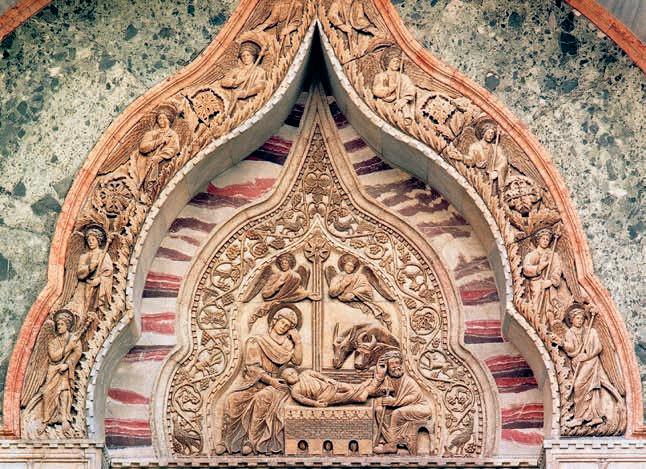 Basilica di San Marco, Porta dei Fiori, dettaglio della Natività, XIII secolo. Per gentile concessione della Procuratoria di San Marco St Mark’s Basilica, Porta dei Fiori, detail from the Nativity, 13th century. By kind permission of the Procuratoria of St Mark
Basilica di San Marco, Porta dei Fiori, dettaglio della Natività, XIII secolo. Per gentile concessione della Procuratoria di San Marco St Mark’s Basilica, Porta dei Fiori, detail from the Nativity, 13th century. By kind permission of the Procuratoria of St Mark
Villa Serego Alighieri in Valpolicella 37015 Gargagnago - Verona - Telefono +39 045 6832511 www.fondazionemasi.com · www.masi.it
FINANCED ACCORDING TO (EU) REGULATION NO. 1308/2013
CAMPAIGN FINANCED ACCORDING TO (EU) REGULATION NO. 1308/2013
CAMPAIGN







 Marco Vigevani, Isabella Bossi Fedrigotti e Sandro Boscaini con i premiati davanti alla botte del Premio Isabella Bossi Fedrigotti, Marco Vigevani and Sandro Boscaini with the winners in front of the Prize Barrel
Marco Vigevani, Isabella Bossi Fedrigotti e Sandro Boscaini con i premiati davanti alla botte del Premio Isabella Bossi Fedrigotti, Marco Vigevani and Sandro Boscaini with the winners in front of the Prize Barrel









 La Basilica e il Leone di San Marco, simbolo universale di Venezia, custoditi dalla Procuratoria
The universal symbol of Venice: the Basilica with the Lion of St Mark, under the tutelage of the Procuratoria
La Basilica e il Leone di San Marco, simbolo universale di Venezia, custoditi dalla Procuratoria
The universal symbol of Venice: the Basilica with the Lion of St Mark, under the tutelage of the Procuratoria

















 Il fruttaio monumentale, alto ben 12 metri, costituirà anche un’attrattiva esperienziale per i visitatori The imposing fruttaio, more than 12 m high, will also add to the attraction for Wine Experience visitors (render by Studio Architetti Mar)
Il fruttaio monumentale, alto ben 12 metri, costituirà anche un’attrattiva esperienziale per i visitatori The imposing fruttaio, more than 12 m high, will also add to the attraction for Wine Experience visitors (render by Studio Architetti Mar)




 Vajo
Photo: Giacomo Boscaini in Dublin
Vajo
Photo: Giacomo Boscaini in Dublin





 Austria
Finlandia
Belgio Islanda Svizzera
Svezia
Austria
Finlandia
Belgio Islanda Svizzera
Svezia









 Olanda Canada, Québec
Saigon, Vietnam
Canada, Québec
Italia
Olanda Canada, Québec
Saigon, Vietnam
Canada, Québec
Italia







































































 Basilica di San Marco, Porta dei Fiori, dettaglio della Natività, XIII secolo. Per gentile concessione della Procuratoria di San Marco St Mark’s Basilica, Porta dei Fiori, detail from the Nativity, 13th century. By kind permission of the Procuratoria of St Mark
Basilica di San Marco, Porta dei Fiori, dettaglio della Natività, XIII secolo. Per gentile concessione della Procuratoria di San Marco St Mark’s Basilica, Porta dei Fiori, detail from the Nativity, 13th century. By kind permission of the Procuratoria of St Mark